
17 Research Proposal Examples

A research proposal systematically and transparently outlines a proposed research project.
The purpose of a research proposal is to demonstrate a project’s viability and the researcher’s preparedness to conduct an academic study. It serves as a roadmap for the researcher.
The process holds value both externally (for accountability purposes and often as a requirement for a grant application) and intrinsic value (for helping the researcher to clarify the mechanics, purpose, and potential signficance of the study).
Key sections of a research proposal include: the title, abstract, introduction, literature review, research design and methods, timeline, budget, outcomes and implications, references, and appendix. Each is briefly explained below.
Watch my Guide: How to Write a Research Proposal
Get your Template for Writing your Research Proposal Here (With AI Prompts!)
Research Proposal Sample Structure
Title: The title should present a concise and descriptive statement that clearly conveys the core idea of the research projects. Make it as specific as possible. The reader should immediately be able to grasp the core idea of the intended research project. Often, the title is left too vague and does not help give an understanding of what exactly the study looks at.
Abstract: Abstracts are usually around 250-300 words and provide an overview of what is to follow – including the research problem , objectives, methods, expected outcomes, and significance of the study. Use it as a roadmap and ensure that, if the abstract is the only thing someone reads, they’ll get a good fly-by of what will be discussed in the peice.
Introduction: Introductions are all about contextualization. They often set the background information with a statement of the problem. At the end of the introduction, the reader should understand what the rationale for the study truly is. I like to see the research questions or hypotheses included in the introduction and I like to get a good understanding of what the significance of the research will be. It’s often easiest to write the introduction last
Literature Review: The literature review dives deep into the existing literature on the topic, demosntrating your thorough understanding of the existing literature including themes, strengths, weaknesses, and gaps in the literature. It serves both to demonstrate your knowledge of the field and, to demonstrate how the proposed study will fit alongside the literature on the topic. A good literature review concludes by clearly demonstrating how your research will contribute something new and innovative to the conversation in the literature.
Research Design and Methods: This section needs to clearly demonstrate how the data will be gathered and analyzed in a systematic and academically sound manner. Here, you need to demonstrate that the conclusions of your research will be both valid and reliable. Common points discussed in the research design and methods section include highlighting the research paradigm, methodologies, intended population or sample to be studied, data collection techniques, and data analysis procedures . Toward the end of this section, you are encouraged to also address ethical considerations and limitations of the research process , but also to explain why you chose your research design and how you are mitigating the identified risks and limitations.
Timeline: Provide an outline of the anticipated timeline for the study. Break it down into its various stages (including data collection, data analysis, and report writing). The goal of this section is firstly to establish a reasonable breakdown of steps for you to follow and secondly to demonstrate to the assessors that your project is practicable and feasible.
Budget: Estimate the costs associated with the research project and include evidence for your estimations. Typical costs include staffing costs, equipment, travel, and data collection tools. When applying for a scholarship, the budget should demonstrate that you are being responsible with your expensive and that your funding application is reasonable.
Expected Outcomes and Implications: A discussion of the anticipated findings or results of the research, as well as the potential contributions to the existing knowledge, theory, or practice in the field. This section should also address the potential impact of the research on relevant stakeholders and any broader implications for policy or practice.
References: A complete list of all the sources cited in the research proposal, formatted according to the required citation style. This demonstrates the researcher’s familiarity with the relevant literature and ensures proper attribution of ideas and information.
Appendices (if applicable): Any additional materials, such as questionnaires, interview guides, or consent forms, that provide further information or support for the research proposal. These materials should be included as appendices at the end of the document.
Research Proposal Examples
Research proposals often extend anywhere between 2,000 and 15,000 words in length. The following snippets are samples designed to briefly demonstrate what might be discussed in each section.
1. Education Studies Research Proposals
See some real sample pieces:
- Assessment of the perceptions of teachers towards a new grading system
- Does ICT use in secondary classrooms help or hinder student learning?
- Digital technologies in focus project
- Urban Middle School Teachers’ Experiences of the Implementation of
- Restorative Justice Practices
- Experiences of students of color in service learning
Consider this hypothetical education research proposal:
The Impact of Game-Based Learning on Student Engagement and Academic Performance in Middle School Mathematics
Abstract: The proposed study will explore multiplayer game-based learning techniques in middle school mathematics curricula and their effects on student engagement. The study aims to contribute to the current literature on game-based learning by examining the effects of multiplayer gaming in learning.
Introduction: Digital game-based learning has long been shunned within mathematics education for fears that it may distract students or lower the academic integrity of the classrooms. However, there is emerging evidence that digital games in math have emerging benefits not only for engagement but also academic skill development. Contributing to this discourse, this study seeks to explore the potential benefits of multiplayer digital game-based learning by examining its impact on middle school students’ engagement and academic performance in a mathematics class.
Literature Review: The literature review has identified gaps in the current knowledge, namely, while game-based learning has been extensively explored, the role of multiplayer games in supporting learning has not been studied.
Research Design and Methods: This study will employ a mixed-methods research design based upon action research in the classroom. A quasi-experimental pre-test/post-test control group design will first be used to compare the academic performance and engagement of middle school students exposed to game-based learning techniques with those in a control group receiving instruction without the aid of technology. Students will also be observed and interviewed in regard to the effect of communication and collaboration during gameplay on their learning.
Timeline: The study will take place across the second term of the school year with a pre-test taking place on the first day of the term and the post-test taking place on Wednesday in Week 10.
Budget: The key budgetary requirements will be the technologies required, including the subscription cost for the identified games and computers.
Expected Outcomes and Implications: It is expected that the findings will contribute to the current literature on game-based learning and inform educational practices, providing educators and policymakers with insights into how to better support student achievement in mathematics.
2. Psychology Research Proposals
See some real examples:
- A situational analysis of shared leadership in a self-managing team
- The effect of musical preference on running performance
- Relationship between self-esteem and disordered eating amongst adolescent females
Consider this hypothetical psychology research proposal:
The Effects of Mindfulness-Based Interventions on Stress Reduction in College Students
Abstract: This research proposal examines the impact of mindfulness-based interventions on stress reduction among college students, using a pre-test/post-test experimental design with both quantitative and qualitative data collection methods .
Introduction: College students face heightened stress levels during exam weeks. This can affect both mental health and test performance. This study explores the potential benefits of mindfulness-based interventions such as meditation as a way to mediate stress levels in the weeks leading up to exam time.
Literature Review: Existing research on mindfulness-based meditation has shown the ability for mindfulness to increase metacognition, decrease anxiety levels, and decrease stress. Existing literature has looked at workplace, high school and general college-level applications. This study will contribute to the corpus of literature by exploring the effects of mindfulness directly in the context of exam weeks.
Research Design and Methods: Participants ( n= 234 ) will be randomly assigned to either an experimental group, receiving 5 days per week of 10-minute mindfulness-based interventions, or a control group, receiving no intervention. Data will be collected through self-report questionnaires, measuring stress levels, semi-structured interviews exploring participants’ experiences, and students’ test scores.
Timeline: The study will begin three weeks before the students’ exam week and conclude after each student’s final exam. Data collection will occur at the beginning (pre-test of self-reported stress levels) and end (post-test) of the three weeks.
Expected Outcomes and Implications: The study aims to provide evidence supporting the effectiveness of mindfulness-based interventions in reducing stress among college students in the lead up to exams, with potential implications for mental health support and stress management programs on college campuses.
3. Sociology Research Proposals
- Understanding emerging social movements: A case study of ‘Jersey in Transition’
- The interaction of health, education and employment in Western China
- Can we preserve lower-income affordable neighbourhoods in the face of rising costs?
Consider this hypothetical sociology research proposal:
The Impact of Social Media Usage on Interpersonal Relationships among Young Adults
Abstract: This research proposal investigates the effects of social media usage on interpersonal relationships among young adults, using a longitudinal mixed-methods approach with ongoing semi-structured interviews to collect qualitative data.
Introduction: Social media platforms have become a key medium for the development of interpersonal relationships, particularly for young adults. This study examines the potential positive and negative effects of social media usage on young adults’ relationships and development over time.
Literature Review: A preliminary review of relevant literature has demonstrated that social media usage is central to development of a personal identity and relationships with others with similar subcultural interests. However, it has also been accompanied by data on mental health deline and deteriorating off-screen relationships. The literature is to-date lacking important longitudinal data on these topics.
Research Design and Methods: Participants ( n = 454 ) will be young adults aged 18-24. Ongoing self-report surveys will assess participants’ social media usage, relationship satisfaction, and communication patterns. A subset of participants will be selected for longitudinal in-depth interviews starting at age 18 and continuing for 5 years.
Timeline: The study will be conducted over a period of five years, including recruitment, data collection, analysis, and report writing.
Expected Outcomes and Implications: This study aims to provide insights into the complex relationship between social media usage and interpersonal relationships among young adults, potentially informing social policies and mental health support related to social media use.
4. Nursing Research Proposals
- Does Orthopaedic Pre-assessment clinic prepare the patient for admission to hospital?
- Nurses’ perceptions and experiences of providing psychological care to burns patients
- Registered psychiatric nurse’s practice with mentally ill parents and their children
Consider this hypothetical nursing research proposal:
The Influence of Nurse-Patient Communication on Patient Satisfaction and Health Outcomes following Emergency Cesarians
Abstract: This research will examines the impact of effective nurse-patient communication on patient satisfaction and health outcomes for women following c-sections, utilizing a mixed-methods approach with patient surveys and semi-structured interviews.
Introduction: It has long been known that effective communication between nurses and patients is crucial for quality care. However, additional complications arise following emergency c-sections due to the interaction between new mother’s changing roles and recovery from surgery.
Literature Review: A review of the literature demonstrates the importance of nurse-patient communication, its impact on patient satisfaction, and potential links to health outcomes. However, communication between nurses and new mothers is less examined, and the specific experiences of those who have given birth via emergency c-section are to date unexamined.
Research Design and Methods: Participants will be patients in a hospital setting who have recently had an emergency c-section. A self-report survey will assess their satisfaction with nurse-patient communication and perceived health outcomes. A subset of participants will be selected for in-depth interviews to explore their experiences and perceptions of the communication with their nurses.
Timeline: The study will be conducted over a period of six months, including rolling recruitment, data collection, analysis, and report writing within the hospital.
Expected Outcomes and Implications: This study aims to provide evidence for the significance of nurse-patient communication in supporting new mothers who have had an emergency c-section. Recommendations will be presented for supporting nurses and midwives in improving outcomes for new mothers who had complications during birth.
5. Social Work Research Proposals
- Experiences of negotiating employment and caring responsibilities of fathers post-divorce
- Exploring kinship care in the north region of British Columbia
Consider this hypothetical social work research proposal:
The Role of a Family-Centered Intervention in Preventing Homelessness Among At-Risk Youthin a working-class town in Northern England
Abstract: This research proposal investigates the effectiveness of a family-centered intervention provided by a local council area in preventing homelessness among at-risk youth. This case study will use a mixed-methods approach with program evaluation data and semi-structured interviews to collect quantitative and qualitative data .
Introduction: Homelessness among youth remains a significant social issue. This study aims to assess the effectiveness of family-centered interventions in addressing this problem and identify factors that contribute to successful prevention strategies.
Literature Review: A review of the literature has demonstrated several key factors contributing to youth homelessness including lack of parental support, lack of social support, and low levels of family involvement. It also demonstrates the important role of family-centered interventions in addressing this issue. Drawing on current evidence, this study explores the effectiveness of one such intervention in preventing homelessness among at-risk youth in a working-class town in Northern England.
Research Design and Methods: The study will evaluate a new family-centered intervention program targeting at-risk youth and their families. Quantitative data on program outcomes, including housing stability and family functioning, will be collected through program records and evaluation reports. Semi-structured interviews with program staff, participants, and relevant stakeholders will provide qualitative insights into the factors contributing to program success or failure.
Timeline: The study will be conducted over a period of six months, including recruitment, data collection, analysis, and report writing.
Budget: Expenses include access to program evaluation data, interview materials, data analysis software, and any related travel costs for in-person interviews.
Expected Outcomes and Implications: This study aims to provide evidence for the effectiveness of family-centered interventions in preventing youth homelessness, potentially informing the expansion of or necessary changes to social work practices in Northern England.
Research Proposal Template
Get your Detailed Template for Writing your Research Proposal Here (With AI Prompts!)
This is a template for a 2500-word research proposal. You may find it difficult to squeeze everything into this wordcount, but it’s a common wordcount for Honors and MA-level dissertations.
Your research proposal is where you really get going with your study. I’d strongly recommend working closely with your teacher in developing a research proposal that’s consistent with the requirements and culture of your institution, as in my experience it varies considerably. The above template is from my own courses that walk students through research proposals in a British School of Education.

Chris Drew (PhD)
Dr. Chris Drew is the founder of the Helpful Professor. He holds a PhD in education and has published over 20 articles in scholarly journals. He is the former editor of the Journal of Learning Development in Higher Education. [Image Descriptor: Photo of Chris]
- Chris Drew (PhD) https://helpfulprofessor.com/author/chris-drew-phd/ 15 Animism Examples
- Chris Drew (PhD) https://helpfulprofessor.com/author/chris-drew-phd/ 10 Magical Thinking Examples
- Chris Drew (PhD) https://helpfulprofessor.com/author/chris-drew-phd/ Social-Emotional Learning (Definition, Examples, Pros & Cons)
- Chris Drew (PhD) https://helpfulprofessor.com/author/chris-drew-phd/ What is Educational Psychology?
8 thoughts on “17 Research Proposal Examples”
Very excellent research proposals
very helpful
Very helpful
Dear Sir, I need some help to write an educational research proposal. Thank you.

Hi Levi, use the site search bar to ask a question and I’ll likely have a guide already written for your specific question. Thanks for reading!
very good research proposal
Thank you so much sir! ❤️
Very helpful 👌
Leave a Comment Cancel Reply
Your email address will not be published. Required fields are marked *

- Research Process
Writing a Scientific Research Project Proposal
- 5 minute read
- 103.2K views
Table of Contents
The importance of a well-written research proposal cannot be underestimated. Your research really is only as good as your proposal. A poorly written, or poorly conceived research proposal will doom even an otherwise worthy project. On the other hand, a well-written, high-quality proposal will increase your chances for success.
In this article, we’ll outline the basics of writing an effective scientific research proposal, including the differences between research proposals, grants and cover letters. We’ll also touch on common mistakes made when submitting research proposals, as well as a simple example or template that you can follow.
What is a scientific research proposal?
The main purpose of a scientific research proposal is to convince your audience that your project is worthwhile, and that you have the expertise and wherewithal to complete it. The elements of an effective research proposal mirror those of the research process itself, which we’ll outline below. Essentially, the research proposal should include enough information for the reader to determine if your proposed study is worth pursuing.
It is not an uncommon misunderstanding to think that a research proposal and a cover letter are the same things. However, they are different. The main difference between a research proposal vs cover letter content is distinct. Whereas the research proposal summarizes the proposal for future research, the cover letter connects you to the research, and how you are the right person to complete the proposed research.
There is also sometimes confusion around a research proposal vs grant application. Whereas a research proposal is a statement of intent, related to answering a research question, a grant application is a specific request for funding to complete the research proposed. Of course, there are elements of overlap between the two documents; it’s the purpose of the document that defines one or the other.
Scientific Research Proposal Format
Although there is no one way to write a scientific research proposal, there are specific guidelines. A lot depends on which journal you’re submitting your research proposal to, so you may need to follow their scientific research proposal template.
In general, however, there are fairly universal sections to every scientific research proposal. These include:
- Title: Make sure the title of your proposal is descriptive and concise. Make it catch and informative at the same time, avoiding dry phrases like, “An investigation…” Your title should pique the interest of the reader.
- Abstract: This is a brief (300-500 words) summary that includes the research question, your rationale for the study, and any applicable hypothesis. You should also include a brief description of your methodology, including procedures, samples, instruments, etc.
- Introduction: The opening paragraph of your research proposal is, perhaps, the most important. Here you want to introduce the research problem in a creative way, and demonstrate your understanding of the need for the research. You want the reader to think that your proposed research is current, important and relevant.
- Background: Include a brief history of the topic and link it to a contemporary context to show its relevance for today. Identify key researchers and institutions also looking at the problem
- Literature Review: This is the section that may take the longest amount of time to assemble. Here you want to synthesize prior research, and place your proposed research into the larger picture of what’s been studied in the past. You want to show your reader that your work is original, and adds to the current knowledge.
- Research Design and Methodology: This section should be very clearly and logically written and organized. You are letting your reader know that you know what you are going to do, and how. The reader should feel confident that you have the skills and knowledge needed to get the project done.
- Preliminary Implications: Here you’ll be outlining how you anticipate your research will extend current knowledge in your field. You might also want to discuss how your findings will impact future research needs.
- Conclusion: This section reinforces the significance and importance of your proposed research, and summarizes the entire proposal.
- References/Citations: Of course, you need to include a full and accurate list of any and all sources you used to write your research proposal.
Common Mistakes in Writing a Scientific Research Project Proposal
Remember, the best research proposal can be rejected if it’s not well written or is ill-conceived. The most common mistakes made include:
- Not providing the proper context for your research question or the problem
- Failing to reference landmark/key studies
- Losing focus of the research question or problem
- Not accurately presenting contributions by other researchers and institutions
- Incompletely developing a persuasive argument for the research that is being proposed
- Misplaced attention on minor points and/or not enough detail on major issues
- Sloppy, low-quality writing without effective logic and flow
- Incorrect or lapses in references and citations, and/or references not in proper format
- The proposal is too long – or too short
Scientific Research Proposal Example
There are countless examples that you can find for successful research proposals. In addition, you can also find examples of unsuccessful research proposals. Search for successful research proposals in your field, and even for your target journal, to get a good idea on what specifically your audience may be looking for.
While there’s no one example that will show you everything you need to know, looking at a few will give you a good idea of what you need to include in your own research proposal. Talk, also, to colleagues in your field, especially if you are a student or a new researcher. We can often learn from the mistakes of others. The more prepared and knowledgeable you are prior to writing your research proposal, the more likely you are to succeed.
Language Editing Services
One of the top reasons scientific research proposals are rejected is due to poor logic and flow. Check out our Language Editing Services to ensure a great proposal , that’s clear and concise, and properly referenced. Check our video for more information, and get started today.

- Manuscript Review
Research Fraud: Falsification and Fabrication in Research Data

Research Team Structure
You may also like.

Descriptive Research Design and Its Myriad Uses

Five Common Mistakes to Avoid When Writing a Biomedical Research Paper

Making Technical Writing in Environmental Engineering Accessible

To Err is Not Human: The Dangers of AI-assisted Academic Writing

When Data Speak, Listen: Importance of Data Collection and Analysis Methods

Choosing the Right Research Methodology: A Guide for Researchers

Why is data validation important in research?

Writing a good review article
Input your search keywords and press Enter.
Organizing Your Social Sciences Research Assignments
- Annotated Bibliography
- Analyzing a Scholarly Journal Article
- Group Presentations
- Dealing with Nervousness
- Using Visual Aids
- Grading Someone Else's Paper
- Types of Structured Group Activities
- Group Project Survival Skills
- Leading a Class Discussion
- Multiple Book Review Essay
- Reviewing Collected Works
- Writing a Case Analysis Paper
- Writing a Case Study
- About Informed Consent
- Writing Field Notes
- Writing a Policy Memo
- Writing a Reflective Paper
- Writing a Research Proposal
- Generative AI and Writing
- Acknowledgments
The goal of a research proposal is twofold: to present and justify the need to study a research problem and to present the practical ways in which the proposed study should be conducted. The design elements and procedures for conducting research are governed by standards of the predominant discipline in which the problem resides, therefore, the guidelines for research proposals are more exacting and less formal than a general project proposal. Research proposals contain extensive literature reviews. They must provide persuasive evidence that a need exists for the proposed study. In addition to providing a rationale, a proposal describes detailed methodology for conducting the research consistent with requirements of the professional or academic field and a statement on anticipated outcomes and benefits derived from the study's completion.
Krathwohl, David R. How to Prepare a Dissertation Proposal: Suggestions for Students in Education and the Social and Behavioral Sciences . Syracuse, NY: Syracuse University Press, 2005.
How to Approach Writing a Research Proposal
Your professor may assign the task of writing a research proposal for the following reasons:
- Develop your skills in thinking about and designing a comprehensive research study;
- Learn how to conduct a comprehensive review of the literature to determine that the research problem has not been adequately addressed or has been answered ineffectively and, in so doing, become better at locating pertinent scholarship related to your topic;
- Improve your general research and writing skills;
- Practice identifying the logical steps that must be taken to accomplish one's research goals;
- Critically review, examine, and consider the use of different methods for gathering and analyzing data related to the research problem; and,
- Nurture a sense of inquisitiveness within yourself and to help see yourself as an active participant in the process of conducting scholarly research.
A proposal should contain all the key elements involved in designing a completed research study, with sufficient information that allows readers to assess the validity and usefulness of your proposed study. The only elements missing from a research proposal are the findings of the study and your analysis of those findings. Finally, an effective proposal is judged on the quality of your writing and, therefore, it is important that your proposal is coherent, clear, and compelling.
Regardless of the research problem you are investigating and the methodology you choose, all research proposals must address the following questions:
- What do you plan to accomplish? Be clear and succinct in defining the research problem and what it is you are proposing to investigate.
- Why do you want to do the research? In addition to detailing your research design, you also must conduct a thorough review of the literature and provide convincing evidence that it is a topic worthy of in-depth study. A successful research proposal must answer the "So What?" question.
- How are you going to conduct the research? Be sure that what you propose is doable. If you're having difficulty formulating a research problem to propose investigating, go here for strategies in developing a problem to study.
Common Mistakes to Avoid
- Failure to be concise . A research proposal must be focused and not be "all over the map" or diverge into unrelated tangents without a clear sense of purpose.
- Failure to cite landmark works in your literature review . Proposals should be grounded in foundational research that lays a foundation for understanding the development and scope of the the topic and its relevance.
- Failure to delimit the contextual scope of your research [e.g., time, place, people, etc.]. As with any research paper, your proposed study must inform the reader how and in what ways the study will frame the problem.
- Failure to develop a coherent and persuasive argument for the proposed research . This is critical. In many workplace settings, the research proposal is a formal document intended to argue for why a study should be funded.
- Sloppy or imprecise writing, or poor grammar . Although a research proposal does not represent a completed research study, there is still an expectation that it is well-written and follows the style and rules of good academic writing.
- Too much detail on minor issues, but not enough detail on major issues . Your proposal should focus on only a few key research questions in order to support the argument that the research needs to be conducted. Minor issues, even if valid, can be mentioned but they should not dominate the overall narrative.
Procter, Margaret. The Academic Proposal. The Lab Report. University College Writing Centre. University of Toronto; Sanford, Keith. Information for Students: Writing a Research Proposal. Baylor University; Wong, Paul T. P. How to Write a Research Proposal. International Network on Personal Meaning. Trinity Western University; Writing Academic Proposals: Conferences, Articles, and Books. The Writing Lab and The OWL. Purdue University; Writing a Research Proposal. University Library. University of Illinois at Urbana-Champaign.
Structure and Writing Style
Beginning the Proposal Process
As with writing most college-level academic papers, research proposals are generally organized the same way throughout most social science disciplines. The text of proposals generally vary in length between ten and thirty-five pages, followed by the list of references. However, before you begin, read the assignment carefully and, if anything seems unclear, ask your professor whether there are any specific requirements for organizing and writing the proposal.
A good place to begin is to ask yourself a series of questions:
- What do I want to study?
- Why is the topic important?
- How is it significant within the subject areas covered in my class?
- What problems will it help solve?
- How does it build upon [and hopefully go beyond] research already conducted on the topic?
- What exactly should I plan to do, and can I get it done in the time available?
In general, a compelling research proposal should document your knowledge of the topic and demonstrate your enthusiasm for conducting the study. Approach it with the intention of leaving your readers feeling like, "Wow, that's an exciting idea and I can’t wait to see how it turns out!"
Most proposals should include the following sections:
I. Introduction
In the real world of higher education, a research proposal is most often written by scholars seeking grant funding for a research project or it's the first step in getting approval to write a doctoral dissertation. Even if this is just a course assignment, treat your introduction as the initial pitch of an idea based on a thorough examination of the significance of a research problem. After reading the introduction, your readers should not only have an understanding of what you want to do, but they should also be able to gain a sense of your passion for the topic and to be excited about the study's possible outcomes. Note that most proposals do not include an abstract [summary] before the introduction.
Think about your introduction as a narrative written in two to four paragraphs that succinctly answers the following four questions :
- What is the central research problem?
- What is the topic of study related to that research problem?
- What methods should be used to analyze the research problem?
- Answer the "So What?" question by explaining why this is important research, what is its significance, and why should someone reading the proposal care about the outcomes of the proposed study?
II. Background and Significance
This is where you explain the scope and context of your proposal and describe in detail why it's important. It can be melded into your introduction or you can create a separate section to help with the organization and narrative flow of your proposal. Approach writing this section with the thought that you can’t assume your readers will know as much about the research problem as you do. Note that this section is not an essay going over everything you have learned about the topic; instead, you must choose what is most relevant in explaining the aims of your research.
To that end, while there are no prescribed rules for establishing the significance of your proposed study, you should attempt to address some or all of the following:
- State the research problem and give a more detailed explanation about the purpose of the study than what you stated in the introduction. This is particularly important if the problem is complex or multifaceted .
- Present the rationale of your proposed study and clearly indicate why it is worth doing; be sure to answer the "So What? question [i.e., why should anyone care?].
- Describe the major issues or problems examined by your research. This can be in the form of questions to be addressed. Be sure to note how your proposed study builds on previous assumptions about the research problem.
- Explain the methods you plan to use for conducting your research. Clearly identify the key sources you intend to use and explain how they will contribute to your analysis of the topic.
- Describe the boundaries of your proposed research in order to provide a clear focus. Where appropriate, state not only what you plan to study, but what aspects of the research problem will be excluded from the study.
- If necessary, provide definitions of key concepts, theories, or terms.
III. Literature Review
Connected to the background and significance of your study is a section of your proposal devoted to a more deliberate review and synthesis of prior studies related to the research problem under investigation . The purpose here is to place your project within the larger whole of what is currently being explored, while at the same time, demonstrating to your readers that your work is original and innovative. Think about what questions other researchers have asked, what methodological approaches they have used, and what is your understanding of their findings and, when stated, their recommendations. Also pay attention to any suggestions for further research.
Since a literature review is information dense, it is crucial that this section is intelligently structured to enable a reader to grasp the key arguments underpinning your proposed study in relation to the arguments put forth by other researchers. A good strategy is to break the literature into "conceptual categories" [themes] rather than systematically or chronologically describing groups of materials one at a time. Note that conceptual categories generally reveal themselves after you have read most of the pertinent literature on your topic so adding new categories is an on-going process of discovery as you review more studies. How do you know you've covered the key conceptual categories underlying the research literature? Generally, you can have confidence that all of the significant conceptual categories have been identified if you start to see repetition in the conclusions or recommendations that are being made.
NOTE: Do not shy away from challenging the conclusions made in prior research as a basis for supporting the need for your proposal. Assess what you believe is missing and state how previous research has failed to adequately examine the issue that your study addresses. Highlighting the problematic conclusions strengthens your proposal. For more information on writing literature reviews, GO HERE .
To help frame your proposal's review of prior research, consider the "five C’s" of writing a literature review:
- Cite , so as to keep the primary focus on the literature pertinent to your research problem.
- Compare the various arguments, theories, methodologies, and findings expressed in the literature: what do the authors agree on? Who applies similar approaches to analyzing the research problem?
- Contrast the various arguments, themes, methodologies, approaches, and controversies expressed in the literature: describe what are the major areas of disagreement, controversy, or debate among scholars?
- Critique the literature: Which arguments are more persuasive, and why? Which approaches, findings, and methodologies seem most reliable, valid, or appropriate, and why? Pay attention to the verbs you use to describe what an author says/does [e.g., asserts, demonstrates, argues, etc.].
- Connect the literature to your own area of research and investigation: how does your own work draw upon, depart from, synthesize, or add a new perspective to what has been said in the literature?
IV. Research Design and Methods
This section must be well-written and logically organized because you are not actually doing the research, yet, your reader must have confidence that you have a plan worth pursuing . The reader will never have a study outcome from which to evaluate whether your methodological choices were the correct ones. Thus, the objective here is to convince the reader that your overall research design and proposed methods of analysis will correctly address the problem and that the methods will provide the means to effectively interpret the potential results. Your design and methods should be unmistakably tied to the specific aims of your study.
Describe the overall research design by building upon and drawing examples from your review of the literature. Consider not only methods that other researchers have used, but methods of data gathering that have not been used but perhaps could be. Be specific about the methodological approaches you plan to undertake to obtain information, the techniques you would use to analyze the data, and the tests of external validity to which you commit yourself [i.e., the trustworthiness by which you can generalize from your study to other people, places, events, and/or periods of time].
When describing the methods you will use, be sure to cover the following:
- Specify the research process you will undertake and the way you will interpret the results obtained in relation to the research problem. Don't just describe what you intend to achieve from applying the methods you choose, but state how you will spend your time while applying these methods [e.g., coding text from interviews to find statements about the need to change school curriculum; running a regression to determine if there is a relationship between campaign advertising on social media sites and election outcomes in Europe ].
- Keep in mind that the methodology is not just a list of tasks; it is a deliberate argument as to why techniques for gathering information add up to the best way to investigate the research problem. This is an important point because the mere listing of tasks to be performed does not demonstrate that, collectively, they effectively address the research problem. Be sure you clearly explain this.
- Anticipate and acknowledge any potential barriers and pitfalls in carrying out your research design and explain how you plan to address them. No method applied to research in the social and behavioral sciences is perfect, so you need to describe where you believe challenges may exist in obtaining data or accessing information. It's always better to acknowledge this than to have it brought up by your professor!
V. Preliminary Suppositions and Implications
Just because you don't have to actually conduct the study and analyze the results, doesn't mean you can skip talking about the analytical process and potential implications . The purpose of this section is to argue how and in what ways you believe your research will refine, revise, or extend existing knowledge in the subject area under investigation. Depending on the aims and objectives of your study, describe how the anticipated results will impact future scholarly research, theory, practice, forms of interventions, or policy making. Note that such discussions may have either substantive [a potential new policy], theoretical [a potential new understanding], or methodological [a potential new way of analyzing] significance. When thinking about the potential implications of your study, ask the following questions:
- What might the results mean in regards to challenging the theoretical framework and underlying assumptions that support the study?
- What suggestions for subsequent research could arise from the potential outcomes of the study?
- What will the results mean to practitioners in the natural settings of their workplace, organization, or community?
- Will the results influence programs, methods, and/or forms of intervention?
- How might the results contribute to the solution of social, economic, or other types of problems?
- Will the results influence policy decisions?
- In what way do individuals or groups benefit should your study be pursued?
- What will be improved or changed as a result of the proposed research?
- How will the results of the study be implemented and what innovations or transformative insights could emerge from the process of implementation?
NOTE: This section should not delve into idle speculation, opinion, or be formulated on the basis of unclear evidence . The purpose is to reflect upon gaps or understudied areas of the current literature and describe how your proposed research contributes to a new understanding of the research problem should the study be implemented as designed.
ANOTHER NOTE : This section is also where you describe any potential limitations to your proposed study. While it is impossible to highlight all potential limitations because the study has yet to be conducted, you still must tell the reader where and in what form impediments may arise and how you plan to address them.
VI. Conclusion
The conclusion reiterates the importance or significance of your proposal and provides a brief summary of the entire study . This section should be only one or two paragraphs long, emphasizing why the research problem is worth investigating, why your research study is unique, and how it should advance existing knowledge.
Someone reading this section should come away with an understanding of:
- Why the study should be done;
- The specific purpose of the study and the research questions it attempts to answer;
- The decision for why the research design and methods used where chosen over other options;
- The potential implications emerging from your proposed study of the research problem; and
- A sense of how your study fits within the broader scholarship about the research problem.
VII. Citations
As with any scholarly research paper, you must cite the sources you used . In a standard research proposal, this section can take two forms, so consult with your professor about which one is preferred.
- References -- a list of only the sources you actually used in creating your proposal.
- Bibliography -- a list of everything you used in creating your proposal, along with additional citations to any key sources relevant to understanding the research problem.
In either case, this section should testify to the fact that you did enough preparatory work to ensure the project will complement and not just duplicate the efforts of other researchers. It demonstrates to the reader that you have a thorough understanding of prior research on the topic.
Most proposal formats have you start a new page and use the heading "References" or "Bibliography" centered at the top of the page. Cited works should always use a standard format that follows the writing style advised by the discipline of your course [e.g., education=APA; history=Chicago] or that is preferred by your professor. This section normally does not count towards the total page length of your research proposal.
Develop a Research Proposal: Writing the Proposal. Office of Library Information Services. Baltimore County Public Schools; Heath, M. Teresa Pereira and Caroline Tynan. “Crafting a Research Proposal.” The Marketing Review 10 (Summer 2010): 147-168; Jones, Mark. “Writing a Research Proposal.” In MasterClass in Geography Education: Transforming Teaching and Learning . Graham Butt, editor. (New York: Bloomsbury Academic, 2015), pp. 113-127; Juni, Muhamad Hanafiah. “Writing a Research Proposal.” International Journal of Public Health and Clinical Sciences 1 (September/October 2014): 229-240; Krathwohl, David R. How to Prepare a Dissertation Proposal: Suggestions for Students in Education and the Social and Behavioral Sciences . Syracuse, NY: Syracuse University Press, 2005; Procter, Margaret. The Academic Proposal. The Lab Report. University College Writing Centre. University of Toronto; Punch, Keith and Wayne McGowan. "Developing and Writing a Research Proposal." In From Postgraduate to Social Scientist: A Guide to Key Skills . Nigel Gilbert, ed. (Thousand Oaks, CA: Sage, 2006), 59-81; Wong, Paul T. P. How to Write a Research Proposal. International Network on Personal Meaning. Trinity Western University; Writing Academic Proposals: Conferences , Articles, and Books. The Writing Lab and The OWL. Purdue University; Writing a Research Proposal. University Library. University of Illinois at Urbana-Champaign.
- << Previous: Writing a Reflective Paper
- Next: Generative AI and Writing >>
- Last Updated: May 7, 2024 9:45 AM
- URL: https://libguides.usc.edu/writingguide/assignments
What’s Included: Research Proposal Template
Our free dissertation/thesis proposal template covers the core essential ingredients for a strong research proposal. It includes clear explanations of what you need to address in each section, as well as straightforward examples and links to further resources.
The research proposal template covers the following core elements:
- Introduction & background (including the research problem)
- Literature review
- Research design / methodology
- Project plan , resource requirements and risk management
The cleanly-formatted Google Doc can be downloaded as a fully editable MS Word Document (DOCX format), so you can use it as-is or convert it to LaTeX.
PS – if you’d like a high-level template for the entire thesis, you can we’ve got that too .
Research Proposal Template FAQS
What types of research proposals can this template be used for.
The proposal template follows the standard format for academic research projects, which means it will be suitable for the vast majority of dissertations and theses (especially those within the sciences), whether they are qualitative or quantitative in terms of design.
Keep in mind that the exact requirements for the introduction chapter/section will vary between universities and degree programs. These are typically minor, but it’s always a good idea to double-check your university’s requirements before you finalise your structure.
Is this template for an undergrad, Master or PhD-level proposal?
This template can be used for a research project at any level of study. Doctoral-level projects typically require the research proposal to be more extensive/comprehensive, but the structure will typically remain the same.
How long should my research proposal be?
The length of a research proposal varies by institution and subject, but as a ballpark, it’s usually between 1,500 and 3,000 words.
To be safe, it’s best to check with your university if they have any preferences or requirements in terms of minimum and maximum word count for the research propsal.
How detailed should the methodology of the proposal be?
You don’t need to go into the fine details of your methodology, but this section should be detailed enough to demonstrate that your research approach is feasible and will address your research questions effectively. Be sure to include your intended methods for data collection and analysis.
Can I include preliminary data or pilot study results in my proposal?
Generally, yes. This can strengthen your proposal by demonstrating the feasibility of your research. However, make sure that your pilot study is approved by your university before collecting any data.
Can I share this template with my friends/colleagues?
Yes, you’re welcome to share this template in its original format (no editing allowed). If you want to post about it on your blog or social media, we kindly request that you reference this page as your source.
What format is the template (DOC, PDF, PPT, etc.)?
The research proposal template is provided as a Google Doc. You can download it in MS Word format or make a copy to your Google Drive. You’re also welcome to convert it to whatever format works best for you, such as LaTeX or PDF.
Do you have templates for the other chapters?
Yes, we do. We are constantly developing our collection of free resources to help students complete their dissertations and theses. You can view all of our template resources here .
Can Grad Coach help me with my dissertation/thesis?
Yes, you’re welcome to get in touch with us to discuss our private coaching services .
Further Resources: Proposal Writing
The template provides step-by-step guidance for each section of your research proposal, but if you’d like to learn more about how to write up a high-quality research proposal, check out the rest of our free proposal-related resources:
- Research Proposal 101
- Examples of research proposals
- How To Find A Research Topic
- How To Find A Research Gap
- Developing Your Golden Thread
- How To Write A Research Proposal
- 8 Common Proposal Writing Mistakes
You can also visit the Grad Coach blog for more proposal-related resources.

If you’d prefer 1-on-1 support with your research proposal, have a look at our private coaching service , where we hold your hand through the research process, step by step.
- Postgraduate
Research degrees
- Examples of Research proposals
- Apply for 2024
- Find a course
- Accessibility
Examples of research proposals
How to write your research proposal, with examples of good proposals.
Research proposals
Your research proposal is a key part of your application. It tells us about the question you want to answer through your research. It is a chance for you to show your knowledge of the subject area and tell us about the methods you want to use.
We use your research proposal to match you with a supervisor or team of supervisors.
In your proposal, please tell us if you have an interest in the work of a specific academic at York St John. You can get in touch with this academic to discuss your proposal. You can also speak to one of our Research Leads. There is a list of our Research Leads on the Apply page.
When you write your proposal you need to:
- Highlight how it is original or significant
- Explain how it will develop or challenge current knowledge of your subject
- Identify the importance of your research
- Show why you are the right person to do this research
- Research Proposal Example 1 (DOC, 49kB)
- Research Proposal Example 2 (DOC, 0.9MB)
- Research Proposal Example 3 (DOC, 55.5kB)
- Research Proposal Example 4 (DOC, 49.5kB)
Subject specific guidance
- Writing a Humanities PhD Proposal (PDF, 0.1MB)
- Writing a Creative Writing PhD Proposal (PDF, 0.1MB)
- About the University
- Our culture and values
- Academic schools
- Academic dates
- Press office
Our wider work
- Business support
- Work in the community
- Donate or support
Connect with us
York St John University
Lord Mayor’s Walk
01904 624 624
York St John London Campus
6th Floor Export Building
1 Clove Crescent
01904 876 944

- Policies and documents
- Module documents
- Programme specifications
- Quality gateway
- Admissions documents
- Access and Participation Plan
- Freedom of information
- Accessibility statement
- Modern slavery and human trafficking statement
© York St John University 2024
Colour Picker
Lorem ipsum dolor sit amet, consectetur adipiscing elit, sed do eiusmod tempor incididunt ut labore et dolore magna aliqua. Dui id ornare arcu odio.
Felis bibendum ut tristique et egestas quis ipsum. Et netus et malesuada fames ac turpis egestas. Faucibus pulvinar elementum integer enim neque volutpat ac. Hac habitasse platea dictumst vestibulum rhoncus.
Nec ullamcorper sit amet risus nullam eget felis eget. Eget felis eget nunc lobortis mattis aliquam faucibus purus.
- Privacy Policy

Home » How To Write A Research Proposal – Step-by-Step [Template]
How To Write A Research Proposal – Step-by-Step [Template]
Table of Contents

How To Write a Research Proposal
Writing a Research proposal involves several steps to ensure a well-structured and comprehensive document. Here is an explanation of each step:
1. Title and Abstract
- Choose a concise and descriptive title that reflects the essence of your research.
- Write an abstract summarizing your research question, objectives, methodology, and expected outcomes. It should provide a brief overview of your proposal.
2. Introduction:
- Provide an introduction to your research topic, highlighting its significance and relevance.
- Clearly state the research problem or question you aim to address.
- Discuss the background and context of the study, including previous research in the field.
3. Research Objectives
- Outline the specific objectives or aims of your research. These objectives should be clear, achievable, and aligned with the research problem.
4. Literature Review:
- Conduct a comprehensive review of relevant literature and studies related to your research topic.
- Summarize key findings, identify gaps, and highlight how your research will contribute to the existing knowledge.
5. Methodology:
- Describe the research design and methodology you plan to employ to address your research objectives.
- Explain the data collection methods, instruments, and analysis techniques you will use.
- Justify why the chosen methods are appropriate and suitable for your research.
6. Timeline:
- Create a timeline or schedule that outlines the major milestones and activities of your research project.
- Break down the research process into smaller tasks and estimate the time required for each task.
7. Resources:
- Identify the resources needed for your research, such as access to specific databases, equipment, or funding.
- Explain how you will acquire or utilize these resources to carry out your research effectively.
8. Ethical Considerations:
- Discuss any ethical issues that may arise during your research and explain how you plan to address them.
- If your research involves human subjects, explain how you will ensure their informed consent and privacy.
9. Expected Outcomes and Significance:
- Clearly state the expected outcomes or results of your research.
- Highlight the potential impact and significance of your research in advancing knowledge or addressing practical issues.

10. References:
- Provide a list of all the references cited in your proposal, following a consistent citation style (e.g., APA, MLA).
11. Appendices:
- Include any additional supporting materials, such as survey questionnaires, interview guides, or data analysis plans.
Research Proposal Format
The format of a research proposal may vary depending on the specific requirements of the institution or funding agency. However, the following is a commonly used format for a research proposal:
1. Title Page:
- Include the title of your research proposal, your name, your affiliation or institution, and the date.
2. Abstract:
- Provide a brief summary of your research proposal, highlighting the research problem, objectives, methodology, and expected outcomes.
3. Introduction:
- Introduce the research topic and provide background information.
- State the research problem or question you aim to address.
- Explain the significance and relevance of the research.
- Review relevant literature and studies related to your research topic.
- Summarize key findings and identify gaps in the existing knowledge.
- Explain how your research will contribute to filling those gaps.
5. Research Objectives:
- Clearly state the specific objectives or aims of your research.
- Ensure that the objectives are clear, focused, and aligned with the research problem.
6. Methodology:
- Describe the research design and methodology you plan to use.
- Explain the data collection methods, instruments, and analysis techniques.
- Justify why the chosen methods are appropriate for your research.
7. Timeline:
8. Resources:
- Explain how you will acquire or utilize these resources effectively.
9. Ethical Considerations:
- If applicable, explain how you will ensure informed consent and protect the privacy of research participants.
10. Expected Outcomes and Significance:
11. References:
12. Appendices:
Research Proposal Template
Here’s a template for a research proposal:
1. Introduction:
2. Literature Review:
3. Research Objectives:
4. Methodology:
5. Timeline:
6. Resources:
7. Ethical Considerations:
8. Expected Outcomes and Significance:
9. References:
10. Appendices:
Research Proposal Sample
Title: The Impact of Online Education on Student Learning Outcomes: A Comparative Study
1. Introduction
Online education has gained significant prominence in recent years, especially due to the COVID-19 pandemic. This research proposal aims to investigate the impact of online education on student learning outcomes by comparing them with traditional face-to-face instruction. The study will explore various aspects of online education, such as instructional methods, student engagement, and academic performance, to provide insights into the effectiveness of online learning.
2. Objectives
The main objectives of this research are as follows:
- To compare student learning outcomes between online and traditional face-to-face education.
- To examine the factors influencing student engagement in online learning environments.
- To assess the effectiveness of different instructional methods employed in online education.
- To identify challenges and opportunities associated with online education and suggest recommendations for improvement.
3. Methodology
3.1 Study Design
This research will utilize a mixed-methods approach to gather both quantitative and qualitative data. The study will include the following components:
3.2 Participants
The research will involve undergraduate students from two universities, one offering online education and the other providing face-to-face instruction. A total of 500 students (250 from each university) will be selected randomly to participate in the study.
3.3 Data Collection
The research will employ the following data collection methods:
- Quantitative: Pre- and post-assessments will be conducted to measure students’ learning outcomes. Data on student demographics and academic performance will also be collected from university records.
- Qualitative: Focus group discussions and individual interviews will be conducted with students to gather their perceptions and experiences regarding online education.
3.4 Data Analysis
Quantitative data will be analyzed using statistical software, employing descriptive statistics, t-tests, and regression analysis. Qualitative data will be transcribed, coded, and analyzed thematically to identify recurring patterns and themes.
4. Ethical Considerations
The study will adhere to ethical guidelines, ensuring the privacy and confidentiality of participants. Informed consent will be obtained, and participants will have the right to withdraw from the study at any time.
5. Significance and Expected Outcomes
This research will contribute to the existing literature by providing empirical evidence on the impact of online education on student learning outcomes. The findings will help educational institutions and policymakers make informed decisions about incorporating online learning methods and improving the quality of online education. Moreover, the study will identify potential challenges and opportunities related to online education and offer recommendations for enhancing student engagement and overall learning outcomes.
6. Timeline
The proposed research will be conducted over a period of 12 months, including data collection, analysis, and report writing.
The estimated budget for this research includes expenses related to data collection, software licenses, participant compensation, and research assistance. A detailed budget breakdown will be provided in the final research plan.
8. Conclusion
This research proposal aims to investigate the impact of online education on student learning outcomes through a comparative study with traditional face-to-face instruction. By exploring various dimensions of online education, this research will provide valuable insights into the effectiveness and challenges associated with online learning. The findings will contribute to the ongoing discourse on educational practices and help shape future strategies for maximizing student learning outcomes in online education settings.
About the author
Muhammad Hassan
Researcher, Academic Writer, Web developer
You may also like

How To Write A Proposal – Step By Step Guide...

Grant Proposal – Example, Template and Guide

How To Write A Business Proposal – Step-by-Step...

Business Proposal – Templates, Examples and Guide

Proposal – Types, Examples, and Writing Guide

How to choose an Appropriate Method for Research?
An official website of the United States government
The .gov means it’s official. Federal government websites often end in .gov or .mil. Before sharing sensitive information, make sure you’re on a federal government site.
The site is secure. The https:// ensures that you are connecting to the official website and that any information you provide is encrypted and transmitted securely.
- Publications
- Account settings
Preview improvements coming to the PMC website in October 2024. Learn More or Try it out now .
- Advanced Search
- Journal List
- v.23(2); 2008 Apr

How to prepare a Research Proposal
Health research, medical education and clinical practice form the three pillars of modern day medical practice. As one authority rightly put it: ‘Health research is not a luxury, but an essential need that no nation can afford to ignore’. Health research can and should be pursued by a broad range of people. Even if they do not conduct research themselves, they need to grasp the principles of the scientific method to understand the value and limitations of science and to be able to assess and evaluate results of research before applying them. This review paper aims to highlight the essential concepts to the students and beginning researchers and sensitize and motivate the readers to access the vast literature available on research methodologies.
Most students and beginning researchers do not fully understand what a research proposal means, nor do they understand its importance. 1 A research proposal is a detailed description of a proposed study designed to investigate a given problem. 2
A research proposal is intended to convince others that you have a worthwhile research project and that you have the competence and the work-plan to complete it. Broadly the research proposal must address the following questions regardless of your research area and the methodology you choose: What you plan to accomplish, why do you want to do it and how are you going to do it. 1 The aim of this article is to highlight the essential concepts and not to provide extensive details about this topic.
The elements of a research proposal are highlighted below:
1. Title: It should be concise and descriptive. It must be informative and catchy. An effective title not only prick’s the readers interest, but also predisposes him/her favorably towards the proposal. Often titles are stated in terms of a functional relationship, because such titles clearly indicate the independent and dependent variables. 1 The title may need to be revised after completion of writing of the protocol to reflect more closely the sense of the study. 3
2. Abstract: It is a brief summary of approximately 300 words. It should include the main research question, the rationale for the study, the hypothesis (if any) and the method. Descriptions of the method may include the design, procedures, the sample and any instruments that will be used. 1 It should stand on its own, and not refer the reader to points in the project description. 3
3. Introduction: The introduction provides the readers with the background information. Its purpose is to establish a framework for the research, so that readers can understand how it relates to other research. 4 It should answer the question of why the research needs to be done and what will be its relevance. It puts the proposal in context. 3
The introduction typically begins with a statement of the research problem in precise and clear terms. 1
The importance of the statement of the research problem 5 : The statement of the problem is the essential basis for the construction of a research proposal (research objectives, hypotheses, methodology, work plan and budget etc). It is an integral part of selecting a research topic. It will guide and put into sharper focus the research design being considered for solving the problem. It allows the investigator to describe the problem systematically, to reflect on its importance, its priority in the country and region and to point out why the proposed research on the problem should be undertaken. It also facilitates peer review of the research proposal by the funding agencies.
Then it is necessary to provide the context and set the stage for the research question in such a way as to show its necessity and importance. 1 This step is necessary for the investigators to familiarize themselves with existing knowledge about the research problem and to find out whether or not others have investigated the same or similar problems. This step is accomplished by a thorough and critical review of the literature and by personal communication with experts. 5 It helps further understanding of the problem proposed for research and may lead to refining the statement of the problem, to identify the study variables and conceptualize their relationships, and in formulation and selection of a research hypothesis. 5 It ensures that you are not "re-inventing the wheel" and demonstrates your understanding of the research problem. It gives due credit to those who have laid the groundwork for your proposed research. 1 In a proposal, the literature review is generally brief and to the point. The literature selected should be pertinent and relevant. 6
Against this background, you then present the rationale of the proposed study and clearly indicate why it is worth doing.
4. Objectives: Research objectives are the goals to be achieved by conducting the research. 5 They may be stated as ‘general’ and ‘specific’.
The general objective of the research is what is to be accomplished by the research project, for example, to determine whether or not a new vaccine should be incorporated in a public health program.
The specific objectives relate to the specific research questions the investigator wants to answer through the proposed study and may be presented as primary and secondary objectives, for example, primary: To determine the degree of protection that is attributable to the new vaccine in a study population by comparing the vaccinated and unvaccinated groups. 5 Secondary: To study the cost-effectiveness of this programme.
Young investigators are advised to resist the temptation to put too many objectives or over-ambitious objectives that cannot be adequately achieved by the implementation of the protocol. 3
5. Variables: During the planning stage, it is necessary to identify the key variables of the study and their method of measurement and unit of measurement must be clearly indicated. Four types of variables are important in research 5 :
a. Independent variables: variables that are manipulated or treated in a study in order to see what effect differences in them will have on those variables proposed as being dependent on them. The different synonyms for the term ‘independent variable’ which are used in literature are: cause, input, predisposing factor, risk factor, determinant, antecedent, characteristic and attribute.
b. Dependent variables: variables in which changes are results of the level or amount of the independent variable or variables.
Synonyms: effect, outcome, consequence, result, condition, disease.
c. Confounding or intervening variables: variables that should be studied because they may influence or ‘mix’ the effect of the independent variables. For instance, in a study of the effect of measles (independent variable) on child mortality (dependent variable), the nutritional status of the child may play an intervening (confounding) role.
d. Background variables: variables that are so often of relevance in investigations of groups or populations that they should be considered for possible inclusion in the study. For example sex, age, ethnic origin, education, marital status, social status etc.
The objective of research is usually to determine the effect of changes in one or more independent variables on one or more dependent variables. For example, a study may ask "Will alcohol intake (independent variable) have an effect on development of gastric ulcer (dependent variable)?"
Certain variables may not be easy to identify. The characteristics that define these variables must be clearly identified for the purpose of the study.
6. Questions and/ or hypotheses: If you as a researcher know enough to make prediction concerning what you are studying, then the hypothesis may be formulated. A hypothesis can be defined as a tentative prediction or explanation of the relationship between two or more variables. In other words, the hypothesis translates the problem statement into a precise, unambiguous prediction of expected outcomes. Hypotheses are not meant to be haphazard guesses, but should reflect the depth of knowledge, imagination and experience of the investigator. 5 In the process of formulating the hypotheses, all variables relevant to the study must be identified. For example: "Health education involving active participation by mothers will produce more positive changes in child feeding than health education based on lectures". Here the independent variable is types of health education and the dependent variable is changes in child feeding.
A research question poses a relationship between two or more variables but phrases the relationship as a question; a hypothesis represents a declarative statement of the relations between two or more variables. 7
For exploratory or phenomenological research, you may not have any hypothesis (please do not confuse the hypothesis with the statistical null hypothesis). 1 Questions are relevant to normative or census type research (How many of them are there? Is there a relationship between them?). Deciding whether to use questions or hypotheses depends on factors such as the purpose of the study, the nature of the design and methodology, and the audience of the research (at times even the outlook and preference of the committee members, particularly the Chair). 6
7. Methodology: The method section is very important because it tells your research Committee how you plan to tackle your research problem. The guiding principle for writing the Methods section is that it should contain sufficient information for the reader to determine whether the methodology is sound. Some even argue that a good proposal should contain sufficient details for another qualified researcher to implement the study. 1 Indicate the methodological steps you will take to answer every question or to test every hypothesis illustrated in the Questions/hypotheses section. 6 It is vital that you consult a biostatistician during the planning stage of your study, 8 to resolve the methodological issues before submitting the proposal.
This section should include:
Research design: The selection of the research strategy is the core of research design and is probably the single most important decision the investigator has to make. The choice of the strategy, whether descriptive, analytical, experimental, operational or a combination of these depend on a number of considerations, 5 but this choice must be explained in relation to the study objectives. 3
Research subjects or participants: Depending on the type of your study, the following questions should be answered 3 , 5
- - What are the criteria for inclusion or selection?
- - What are the criteria for exclusion?
- - What is the sampling procedure you will use so as to ensure representativeness and reliability of the sample and to minimize sampling errors? The key reason for being concerned with sampling is the issue of validity-both internal and external of the study results. 9
- - Will there be use of controls in your study? Controls or comparison groups are used in scientific research in order to increase the validity of the conclusions. Control groups are necessary in all analytical epidemiological studies, in experimental studies of drug trials, in research on effects of intervention programmes and disease control measures and in many other investigations. Some descriptive studies (studies of existing data, surveys) may not require control groups.
- - What are the criteria for discontinuation?
Sample size: The proposal should provide information and justification (basis on which the sample size is calculated) about sample size in the methodology section. 3 A larger sample size than needed to test the research hypothesis increases the cost and duration of the study and will be unethical if it exposes human subjects to any potential unnecessary risk without additional benefit. A smaller sample size than needed can also be unethical as it exposes human subjects to risk with no benefit to scientific knowledge. Calculation of sample size has been made easy by computer software programmes, but the principles underlying the estimation should be well understood.
Interventions: If an intervention is introduced, a description must be given of the drugs or devices (proprietary names, manufacturer, chemical composition, dose, frequency of administration) if they are already commercially available. If they are in phases of experimentation or are already commercially available but used for other indications, information must be provided on available pre-clinical investigations in animals and/or results of studies already conducted in humans (in such cases, approval of the drug regulatory agency in the country is needed before the study). 3
Ethical issues 3 : Ethical considerations apply to all types of health research. Before the proposal is submitted to the Ethics Committee for approval, two important documents mentioned below (where appropriate) must be appended to the proposal. In additions, there is another vital issue of Conflict of Interest, wherein the researchers should furnish a statement regarding the same.
The Informed consent form (informed decision-making): A consent form, where appropriate, must be developed and attached to the proposal. It should be written in the prospective subjects’ mother tongue and in simple language which can be easily understood by the subject. The use of medical terminology should be avoided as far as possible. Special care is needed when subjects are illiterate. It should explain why the study is being done and why the subject has been asked to participate. It should describe, in sequence, what will happen in the course of the study, giving enough detail for the subject to gain a clear idea of what to expect. It should clarify whether or not the study procedures offer any benefits to the subject or to others, and explain the nature, likelihood and treatment of anticipated discomfort or adverse effects, including psychological and social risks, if any. Where relevant, a comparison with risks posed by standard drugs or treatment must be included. If the risks are unknown or a comparative risk cannot be given it should be so stated. It should indicate that the subject has the right to withdraw from the study at any time without, in any way, affecting his/her further medical care. It should assure the participant of confidentiality of the findings.
Ethics checklist: The proposal must describe the measures that will be undertaken to ensure that the proposed research is carried out in accordance with the World Medical Association Declaration of Helsinki on Ethical Principles for Medical research involving Human Subjects. 10 It must answer the following questions:
- • Is the research design adequate to provide answers to the research question? It is unethical to expose subjects to research that will have no value.
- • Is the method of selection of research subjects justified? The use of vulnerable subjects as research participants needs special justification. Vulnerable subjects include those in prison, minors and persons with mental disability. In international research it is important to mention that the population in which the study is conducted will benefit from any potential outcome of the research and the research is not being conducted solely for the benefit of some other population. Justification is needed for any inducement, financial or otherwise, for the participants to be enrolled in the study.
- • Are the interventions justified, in terms of risk/benefit ratio? Risks are not limited to physical harm. Psychological and social risks must also be considered.
- • For observations made, have measures been taken to ensure confidentiality?
Research setting 5 : The research setting includes all the pertinent facets of the study, such as the population to be studied (sampling frame), the place and time of study.
Study instruments 3 , 5 : Instruments are the tools by which the data are collected. For validated questionnaires/interview schedules, reference to published work should be given and the instrument appended to the proposal. For new a questionnaire which is being designed specifically for your study the details about preparing, precoding and pretesting of questionnaire should be furnished and the document appended to the proposal. Descriptions of other methods of observations like medical examination, laboratory tests and screening procedures is necessary- for established procedures, reference of published work cited but for new or modified procedure, an adequate description is necessary with justification for the same.
Collection of data: A short description of the protocol of data collection. For example, in a study on blood pressure measurement: time of participant arrival, rest for 5p. 10 minutes, which apparatus (standard calibrated) to be used, in which room to take measurement, measurement in sitting or lying down position, how many measurements, measurement in which arm first (whether this is going to be randomized), details of cuff and its placement, who will take the measurement. This minimizes the possibility of confusion, delays and errors.
Data analysis: The description should include the design of the analysis form, plans for processing and coding the data and the choice of the statistical method to be applied to each data. What will be the procedures for accounting for missing, unused or spurious data?
Monitoring, supervision and quality control: Detailed statement about the all logistical issues to satisfy the requirements of Good Clinical Practices (GCP), protocol procedures, responsibilities of each member of the research team, training of study investigators, steps taken to assure quality control (laboratory procedures, equipment calibration etc)
Gantt chart: A Gantt chart is an overview of tasks/proposed activities and a time frame for the same. You put weeks, days or months at one side, and the tasks at the other. You draw fat lines to indicate the period the task will be performed to give a timeline for your research study (take help of tutorial on youtube). 11
Significance of the study: Indicate how your research will refine, revise or extend existing knowledge in the area under investigation. How will it benefit the concerned stakeholders? What could be the larger implications of your research study?
Dissemination of the study results: How do you propose to share the findings of your study with professional peers, practitioners, participants and the funding agency?
Budget: A proposal budget with item wise/activity wise breakdown and justification for the same. Indicate how will the study be financed.
References: The proposal should end with relevant references on the subject. For web based search include the date of access for the cited website, for example: add the sentence "accessed on June 10, 2008".
Appendixes: Include the appropriate appendixes in the proposal. For example: Interview protocols, sample of informed consent forms, cover letters sent to appropriate stakeholders, official letters for permission to conduct research. Regarding original scales or questionnaires, if the instrument is copyrighted then permission in writing to reproduce the instrument from the copyright holder or proof of purchase of the instrument must be submitted.

Science & Quantitative Reasoning Education
Yale undergraduate research, how to write a proposal.
The abstract should summarize your proposal. Include one sentence to introduce the problem you are investigating, why this problem is significant, the hypothesis to be tested, a brief summary of experiments that you wish to conduct and a single concluding sentence. (250 word limit)
Introduction
The introduction discusses the background and significance of the problem you are investigating. Lead the reader from the general to the specific. For example, if you want to write about the role that Brca1 mutations play in breast cancer pathogenesis, talk first about the significance of breast cancer as a disease in the US/world population, then about familial breast cancer as a small subset of breast cancers in general, then about discovery of Brca1 mutations in familial breast cancer, then Brca1’s normal functions in DNA repair, then about how Brca1 mutations result in damaged DNA and onset of familial breast cancer, etc. Definitely include figures with properly labeled text boxes (designated as Figure 1, Figure 2, etc) here to better illustrate your points and help your reader wade through unfamiliar science. (3 pages max)
Formulate a hypothesis that will be tested in your grant proposal. Remember, you are doing hypothesis-driven research so there should be a hypothesis to be tested! The hypothesis should be focused, concise and flow logically from the introduction. For example, your hypothesis could be “I hypothesize that overexpressing wild type Brca1 in Brca1 null tumor cells will prevent metastatic spread in a mouse xenograph model.” Based on your hypothesis, your Specific Aims section should be geared to support it. The hypothesis is stated in one sentence in the proposal.
Specific Aims (listed as Specific Aim 1, Specific Aim 2)
This is where you will want to work with your mentor to craft the experimental portion of your proposal. Propose two original specific aims to test your hypothesis. Don’t propose more than two aims-you will NOT have enough time to do more. In the example presented, Specific Aim 1 might be “To determine the oncogenic potential of Brca1 null cell lines expressing wild type Brca1 cDNA”. Specific aim 2 might be “To determine the metastatic potential of Brca1 null cells that express WT Brca1”. You do not have to go into extensive technical details, just enough for the reader to understand what you propose to do. The best aims yield mechanistic insights-that is, experiments proposed address some mechanisms of biology. A less desirable aim proposes correlative experiments that does not address mechanistically how BRCA1 mutations generate cancer. It is also very important that the two aims are related but NOT interdependent. What this means is that if Aim 1 doesn’t work, Aim 2 is not automatically dead. For example, say you propose in Aim 1 to generate a BRCA1 knockout mouse model, and in Aim 2 you will take tissues from this mouse to do experiments. If knocking out BRCA1 results in early embryonic death, you will never get a mouse that yields tissues for Aim 2. You can include some of your mentor’s data here as “Preliminary data”. Remember to carefully cite all your sources. (4 pages max; 2 pages per Aim)
Potential pitfalls and alternative strategies
This is a very important part of any proposal. This is where you want to discuss the experiments you propose in Aims 1 and 2. Remember, no experiment is perfect. Are there any reasons why experiments you proposed might not work? Why? What will you do to resolve this? What are other possible strategies you might use if your experiments don’t work? If a reviewer spots these deficiencies and you don’t propose methods to correct them, your proposal will not get funded. You will want to work with your mentor to write this section. (1/2 page per Aim)
Cite all references, including unpublished data from your mentor. Last, First, (year), Title, Journal, volume, pages.
*8 page proposal limit (not including References), 1.5 spacing, 12pt Times New Roman font
- View an example of a research proposal submitted for the Yale College First-Year Summer Research Fellowship (PDF).
- View an example of a research proposal submitted for the Yale College Dean’s Research Fellowship and the Rosenfeld Science Scholars Program (PDF) .
- Sample Research
FREE 10+ Scientific Research Proposal Samples in MS Word | PDF

Are you contemplating on having a career in science? In science, every theory and interpretation is continually examined and challenged, regardless of when it was originally introduced. Scientific understanding is a very dynamic process and always susceptible to change. The main purpose of scientific research is to discover truth and have a genuine knowledge advancement. In this article, we will discuss beneficial steps of creating a scientific research proposal , plus we have various downloadable proposal templates for you to use. Keep on reading!
Scientific Research Proposal
Free 10+ scientific research proposal samples, 1. scientific research proposal template, 2. seed research proposal template, 3. scientific research hypothesis proposal, 4. study scientific research proposal, 5. scientific research proposal structure, 6. sample scientific research proposal, 7. phd research proposal checklist, 8. simple research proposal template, 9. basic science research proposal, 10. student scientific research proposal, 11. scientific research proposal format, what is a scientific research proposal, how to create a scientific research proposal , 1. specify the research problem, scientific goals, and objectives, 2. use a mathematical research model , 3. explain your methods and materials, 4. indicate a realistic schedule , 5. emphasize the significance of your research, what are the important elements that should be included in a scientific proposal, what are good topics for a scientific research proposal, how long is a phd research proposal, how do i choose a research topic.
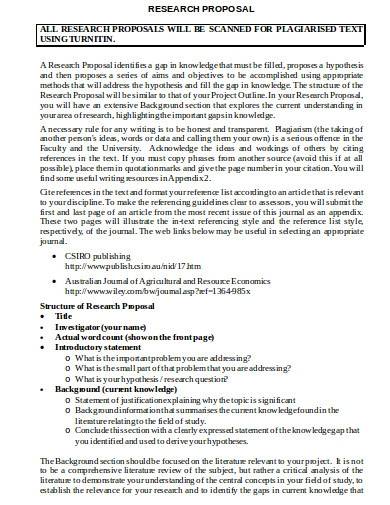
Size: 415 KB
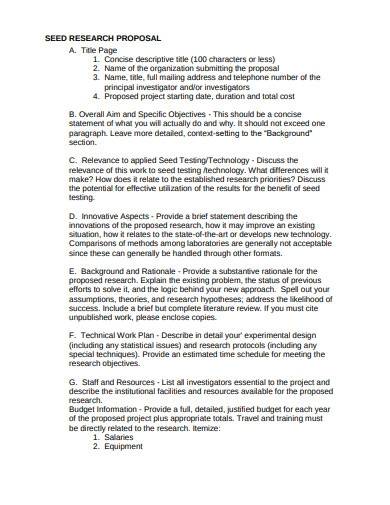
Size: 111 KB
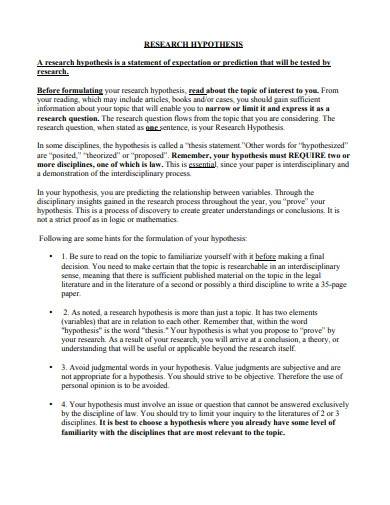
Size: 107 KB
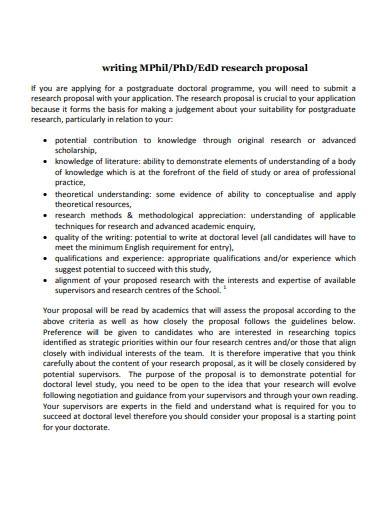
Size: 333 KB
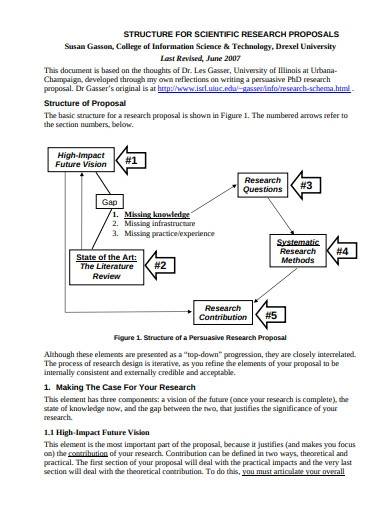
Size: 32 KB
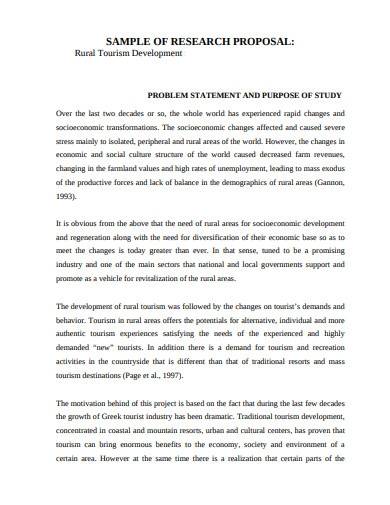
Size: 92 KB
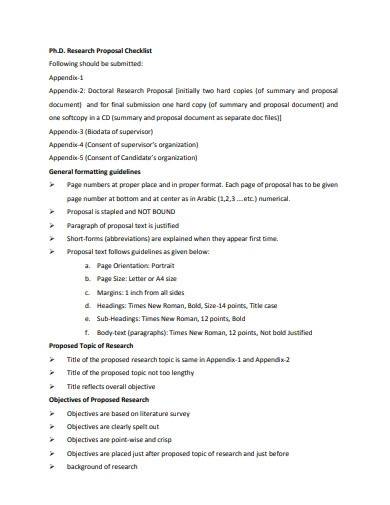
Size: 774 KB
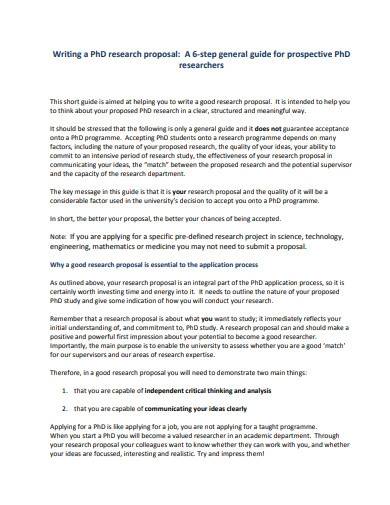
Size: 91 KB
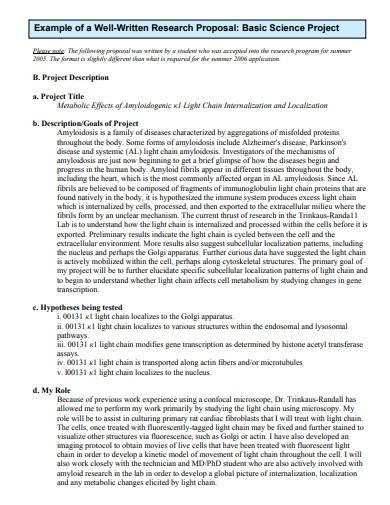
Size: 110 KB
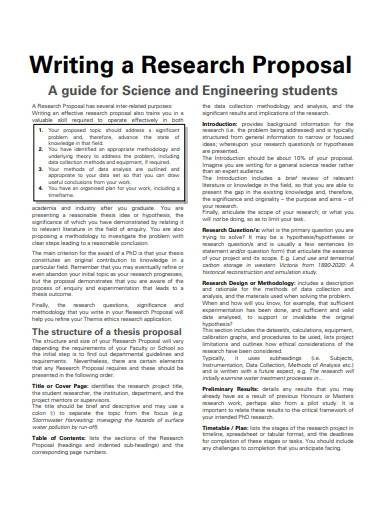
Size: 105 KB
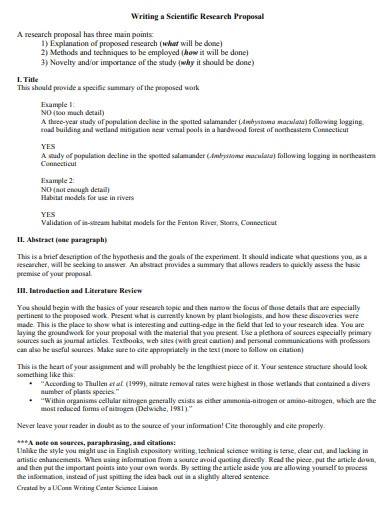
Size: 96 KB
Finlay MacRitchie described scientific research from the book “ Scientific Research as a Career ” as an exploration into the unknown. That’s why in recent decades, there has been an increasing involvement of business management principles into research control.
A proposal for scientific research is an essential document that comprises research goals, objectives, and methods created by the researchers or scientists as they work on their curious mind with a deep knowledge of a specific or many areas of science and become intensely focused on the research problem, especially to attain research grants and awards.
The “ Handbook of Scientific Proposal Writing ” explained that there are various factors that play a crucial role in achieving research grants and awards. Many funding agencies expect research proposals to have three interrelated characteristics such as broader merit, intellectual merit, and feasibility of success. Plus, the dynamics of proposal submission and evaluation process is crucial to obtaining research grants.
In this matter, we suggest that you follow the steps below while freely using one of our templates in this article:
One of the primary aspects that you need to consider in creating a proposal for scientific research is specifying the research problem, scientific goals, and objectives. This can be viewed as solving or completing a puzzle. But in this puzzle analogy, acquiring the lost pieces may need some steps that may go far beyond searching for them.
To create an effective proposal , you need to apply a mathematical research model as you get research content of projects that are based on mathematical formalisms. For example, use a number theory in your research work. Axioms establish the ground rules in a mathematical investigation. Likewise, experimental observations form the foundation of physical research.
You need to explain how you will gather and analyze data on each variable you indicate in your hypotheses. Predictions from those hypotheses are necessary to be clearly stated. So, you may include a comprehensive ethogram or coding system in the methods part with reference. Describe the type of materials you will be using for your research study .
Remember to indicate a realistic schedule of research by listing the specific time or the type of sequence each phase of your project will happen. This will allow reviewers to evaluate if you have budgeted adequate time to finish your proposed research work.
According to the book “ Planning, Proposing, and Presenting Science Effectively ,” you must clearly emphasize the content of your research proposal as you explain the relevance of your study to your primary objectives. This will provide you an opportunity to highlight additional contributions that your study potentially creates. Thoroughly explain why your choice of study subjects, locations, or method are very uniquely yours.
The important elements that should be included in a scientific proposal:
- Background and rationale
- Research questions
- Research methodology
- Work plan and time schedule
- Bibliography
It is essential that you need to be an expert of searching for the proper research paper topics. Some good topics that you can use for writing a research proposal are biotechnology, hydroponic gardening, criminal psychology, intelligence tests, learning disabilities, memory, and virology..
PhD research proposals are usually between 1,500 and 3,000 words in length.
Keep on brainstorming for ideas. Select a topic that will enable you to read and understand the literature. Make sure that the topic is manageable and that material is available. Create a list of keywords. Be flexible and research more about your topic.
Therefore, scientific research cultivates our culture and drives the technology that has significantly improved the living conditions in which many humans live. It is certainly one of the most noble professions. Additionally, when you are working as a researcher, it helps you to create friendships with your colleagues in different parts of the world, giving you opportunities for travelling abroad and nurturing those friendships. So, get a proposal template today to start your scientific research journey!
Related Posts
Free 34 research papers in pdf, free 9+ one-page proposal samples in pdf ms word, free 20+ research paper outlines in pdf ms word, free 8+ sample scientific reports in pdf ms word | google docs, free 6+ sample case study templates in pdf psd, free 10+ research ethics samples & templates in ms word pdf, free 6+ sample of apa paper templates in ms word pdf, free 10+ academic research plan samples and templates in pdf, free 7+ sample cover page for research paper templates in ms ..., free 8+ research monograph samples in pdf ms word, free 13+ abstract writing samples and templates in pdf, free 10+ thesis proposals in google docs ms word | pages | pdf, free 7+ sample research project templates in pdf ms word, free 7+ engineering proposal templates in ms word pdf ..., free 22+ endorsement letter samples & templates in pdf ms ..., free 35+ proposal letter format samples in pdf ms word ..., free 11+ sample research plan templates in ms word pdf, free 11+ research plan samples in pdf ms word, free 10+ sample research statement templates in pdf ms word.
Organizing Your Social Sciences Research Paper: Writing a Research Proposal
- Purpose of Guide
- Writing a Research Proposal
- Design Flaws to Avoid
- Independent and Dependent Variables
- Narrowing a Topic Idea
- Broadening a Topic Idea
- The Research Problem/Question
- Academic Writing Style
- Choosing a Title
- Making an Outline
- Paragraph Development
- The C.A.R.S. Model
- Background Information
- Theoretical Framework
- Citation Tracking
- Evaluating Sources
- Reading Research Effectively
- Primary Sources
- Secondary Sources
- What Is Scholarly vs. Popular?
- Is it Peer-Reviewed?
- Qualitative Methods
- Quantitative Methods
- Common Grammar Mistakes
- Writing Concisely
- Avoiding Plagiarism [linked guide]
- Annotated Bibliography
- Grading Someone Else's Paper
The goal of a research proposal is to present and justify the need to study a research problem and to present the practical ways in which the proposed study should be conducted. The design elements and procedures for conducting the research are governed by standards within the predominant discipline in which the problem resides, so guidelines for research proposals are more exacting and less formal than a general project proposal. Research proposals contain extensive literature reviews. They must provide persuasive evidence that a need exists for the proposed study. In addition to providing a rationale, a proposal describes detailed methodology for conducting the research consistent with requirements of the professional or academic field and a statement on anticipated outcomes and/or benefits derived from the study's completion.
Krathwohl, David R. How to Prepare a Dissertation Proposal: Suggestions for Students in Education and the Social and Behavioral Sciences . Syracuse, NY: Syracuse University Press, 2005.
How to Approach Writing a Research Proposal
Your professor may assign the task of writing a research proposal for the following reasons:
- Develop your skills in thinking about and designing a comprehensive research study;
- Learn how to conduct a comprehensive review of the literature to ensure a research problem has not already been answered [or you may determine the problem has been answered ineffectively] and, in so doing, become better at locating scholarship related to your topic;
- Improve your general research and writing skills;
- Practice identifying the logical steps that must be taken to accomplish one's research goals;
- Critically review, examine, and consider the use of different methods for gathering and analyzing data related to the research problem; and,
- Nurture a sense of inquisitiveness within yourself and to help see yourself as an active participant in the process of doing scholarly research.
A proposal should contain all the key elements involved in designing a completed research study, with sufficient information that allows readers to assess the validity and usefulness of your proposed study. The only elements missing from a research proposal are the findings of the study and your analysis of those results. Finally, an effective proposal is judged on the quality of your writing and, therefore, it is important that your writing is coherent, clear, and compelling.
Regardless of the research problem you are investigating and the methodology you choose, all research proposals must address the following questions:
- What do you plan to accomplish? Be clear and succinct in defining the research problem and what it is you are proposing to research.
- Why do you want to do it? In addition to detailing your research design, you also must conduct a thorough review of the literature and provide convincing evidence that it is a topic worthy of study. Be sure to answer the "So What?" question.
- How are you going to do it? Be sure that what you propose is doable. If you're having trouble formulating a research problem to propose investigating, go here .
Common Mistakes to Avoid
- Failure to be concise; being "all over the map" without a clear sense of purpose.
- Failure to cite landmark works in your literature review.
- Failure to delimit the contextual boundaries of your research [e.g., time, place, people, etc.].
- Failure to develop a coherent and persuasive argument for the proposed research.
- Failure to stay focused on the research problem; going off on unrelated tangents.
- Sloppy or imprecise writing, or poor grammar.
- Too much detail on minor issues, but not enough detail on major issues.
Procter, Margaret. The Academic Proposal . The Lab Report. University College Writing Centre. University of Toronto; Sanford, Keith. Information for Students: Writing a Research Proposal . Baylor University; Wong, Paul T. P. How to Write a Research Proposal . International Network on Personal Meaning. Trinity Western University; Writing Academic Proposals: Conferences, Articles, and Books . The Writing Lab and The OWL. Purdue University; Writing a Research Proposal . University Library. University of Illinois at Urbana-Champaign.
Structure and Writing Style
Beginning the Proposal Process
As with writing a regular academic paper, research proposals are generally organized the same way throughout most social science disciplines. Proposals vary between ten and twenty-five pages in length. However, before you begin, read the assignment carefully and, if anything seems unclear, ask your professor whether there are any specific requirements for organizing and writing the proposal.
A good place to begin is to ask yourself a series of questions:
- What do I want to study?
- Why is the topic important?
- How is it significant within the subject areas covered in my class?
- What problems will it help solve?
- How does it build upon [and hopefully go beyond] research already conducted on the topic?
- What exactly should I plan to do, and can I get it done in the time available?
In general, a compelling research proposal should document your knowledge of the topic and demonstrate your enthusiasm for conducting the study. Approach it with the intention of leaving your readers feeling like--"Wow, that's an exciting idea and I can’t wait to see how it turns out!"
In general your proposal should include the following sections:
I. Introduction
In the real world of higher education, a research proposal is most often written by scholars seeking grant funding for a research project or it's the first step in getting approval to write a doctoral dissertation. Even if this is just a course assignment, treat your introduction as the initial pitch of an idea or a thorough examination of the significance of a research problem. After reading the introduction, your readers should not only have an understanding of what you want to do, but they should also be able to gain a sense of your passion for the topic and be excited about the study's possible outcomes. Note that most proposals do not include an abstract [summary] before the introduction.
Think about your introduction as a narrative written in one to three paragraphs that succinctly answers the following four questions :
- What is the central research problem?
- What is the topic of study related to that problem?
- What methods should be used to analyze the research problem?
- Why is this important research, what is its significance, and why should someone reading the proposal care about the outcomes of the proposed study?
II. Background and Significance
This section can be melded into your introduction or you can create a separate section to help with the organization and narrative flow of your proposal. This is where you explain the context of your proposal and describe in detail why it's important. Approach writing this section with the thought that you can’t assume your readers will know as much about the research problem as you do. Note that this section is not an essay going over everything you have learned about the topic; instead, you must choose what is relevant to help explain the goals for your study.
To that end, while there are no hard and fast rules, you should attempt to address some or all of the following key points:
- State the research problem and give a more detailed explanation about the purpose of the study than what you stated in the introduction. This is particularly important if the problem is complex or multifaceted .
- Present the rationale of your proposed study and clearly indicate why it is worth doing. Answer the "So What? question [i.e., why should anyone care].
- Describe the major issues or problems to be addressed by your research. Be sure to note how your proposed study builds on previous assumptions about the research problem.
- Explain how you plan to go about conducting your research. Clearly identify the key sources you intend to use and explain how they will contribute to your analysis of the topic.
- Set the boundaries of your proposed research in order to provide a clear focus. Where appropriate, state not only what you will study, but what is excluded from the study.
- If necessary, provide definitions of key concepts or terms.
III. Literature Review
Connected to the background and significance of your study is a section of your proposal devoted to a more deliberate review and synthesis of prior studies related to the research problem under investigation . The purpose here is to place your project within the larger whole of what is currently being explored, while demonstrating to your readers that your work is original and innovative. Think about what questions other researchers have asked, what methods they have used, and what is your understanding of their findings and, where stated, their recommendations. Do not be afraid to challenge the conclusions of prior research. Assess what you believe is missing and state how previous research has failed to adequately examine the issue that your study addresses. For more information on writing literature reviews, GO HERE .
Since a literature review is information dense, it is crucial that this section is intelligently structured to enable a reader to grasp the key arguments underpinning your study in relation to that of other researchers. A good strategy is to break the literature into "conceptual categories" [themes] rather than systematically describing groups of materials one at a time. Note that conceptual categories generally reveal themselves after you have read most of the pertinent literature on your topic so adding new categories is an on-going process of discovery as you read more studies. How do you know you've covered the key conceptual categories underlying the research literature? Generally, you can have confidence that all of the significant conceptual categories have been identified if you start to see repetition in the conclusions or recommendations that are being made.
To help frame your proposal's literature review, here are the "five C’s" of writing a literature review:
- Cite , so as to keep the primary focus on the literature pertinent to your research problem.
- Compare the various arguments, theories, methodologies, and findings expressed in the literature: what do the authors agree on? Who applies similar approaches to analyzing the research problem?
- Contrast the various arguments, themes, methodologies, approaches, and controversies expressed in the literature: what are the major areas of disagreement, controversy, or debate?
- Critique the literature: Which arguments are more persuasive, and why? Which approaches, findings, methodologies seem most reliable, valid, or appropriate, and why? Pay attention to the verbs you use to describe what an author says/does [e.g., asserts, demonstrates, argues, etc.] .
- Connect the literature to your own area of research and investigation: how does your own work draw upon, depart from, synthesize, or add a new perspective to what has been said in the literature?
IV. Research Design and Methods
This section must be well-written and logically organized because you are not actually doing the research, yet, your reader must have confidence that it is worth pursuing . The reader will never have a study outcome from which to evaluate whether your methodological choices were the correct ones. Thus, the objective here is to convince the reader that your overall research design and methods of analysis will correctly address the problem and that the methods will provide the means to effectively interpret the potential results. Your design and methods should be unmistakably tied to the specific aims of your study.
Describe the overall research design by building upon and drawing examples from your review of the literature. Consider not only methods that other researchers have used but methods of data gathering that have not been used but perhaps could be. Be specific about the methodological approaches you plan to undertake to obtain information, the techniques you would use to analyze the data, and the tests of external validity to which you commit yourself [i.e., the trustworthiness by which you can generalize from your study to other people, places, events, and/or periods of time].
When describing the methods you will use, be sure to cover the following:
- Specify the research operations you will undertake and the way you will interpret the results of these operations in relation to the research problem. Don't just describe what you intend to achieve from applying the methods you choose, but state how you will spend your time while applying these methods [e.g., coding text from interviews to find statements about the need to change school curriculum; running a regression to determine if there is a relationship between campaign advertising on social media sites and election outcomes in Europe ].
- Keep in mind that a methodology is not just a list of tasks; it is an argument as to why these tasks add up to the best way to investigate the research problem. This is an important point because the mere listing of tasks to be performed does not demonstrate that, collectively, they effectively address the research problem. Be sure you explain this.
- Anticipate and acknowledge any potential barriers and pitfalls in carrying out your research design and explain how you plan to address them. No method is perfect so you need to describe where you believe challenges may exist in obtaining data or accessing information. It's always better to acknowledge this than to have it brought up by your reader.
Develop a Research Proposal: Writing the Proposal . Office of Library Information Services. Baltimore County Public Schools; Heath, M. Teresa Pereira and Caroline Tynan. “Crafting a Research Proposal.” The Marketing Review 10 (Summer 2010): 147-168; Jones, Mark. “Writing a Research Proposal.” In MasterClass in Geography Education: Transforming Teaching and Learning . Graham Butt, editor. (New York: Bloomsbury Academic, 2015), pp. 113-127; Juni, Muhamad Hanafiah. “Writing a Research Proposal.” International Journal of Public Health and Clinical Sciences 1 (September/October 2014): 229-240; Krathwohl, David R. How to Prepare a Dissertation Proposal: Suggestions for Students in Education and the Social and Behavioral Sciences . Syracuse, NY: Syracuse University Press, 2005; Procter, Margaret. The Academic Proposal . The Lab Report. University College Writing Centre. University of Toronto; Punch, Keith and Wayne McGowan. "Developing and Writing a Research Proposal." In From Postgraduate to Social Scientist: A Guide to Key Skills . Nigel Gilbert, ed. (Thousand Oaks, CA: Sage, 2006), 59-81; Wong, Paul T. P. How to Write a Research Proposal . International Network on Personal Meaning. Trinity Western University; Writing Academic Proposals: Conferences, Articles, and Books . The Writing Lab and The OWL. Purdue University; Writing a Research Proposal . University Library. University of Illinois at Urbana-Champaign.
- << Previous: Purpose of Guide
- Next: Types of Research Designs >>
- Last Updated: Sep 8, 2023 12:19 PM
- URL: https://guides.library.txstate.edu/socialscienceresearch
13+ SAMPLE Scientific Research Proposal in PDF | MS Word

Scientific Research Proposal | MS Word
13+ sample scientific research proposal, what is a scientific research proposal, elements of a scientific research proposal, tips on scientific research proposal, how to create a scientific research proposal, what are the benefits of a scientific research proposal, is a scientific research proposal important.

Scientific Research Proposal Template

Basic Scientific Research Proposal
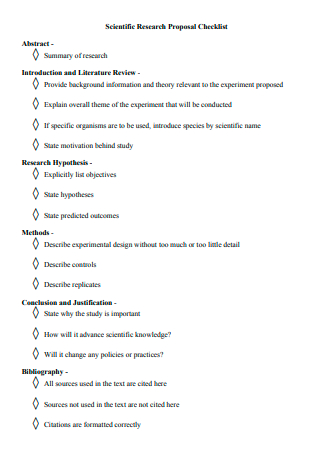
Scientific Research Proposal Checklist

Scientific Research Proposal in PDF

Scientific Theoretical Research Proposal

Scientific Research Grant Call For Proposal
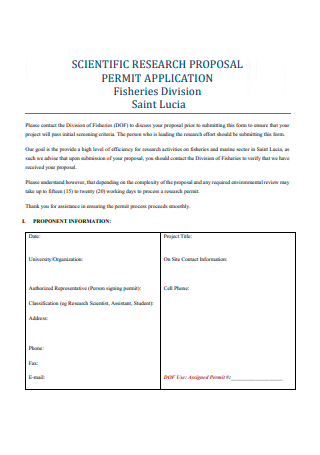
Scientific Research Proposal Application

Scientific Research Proposal Example
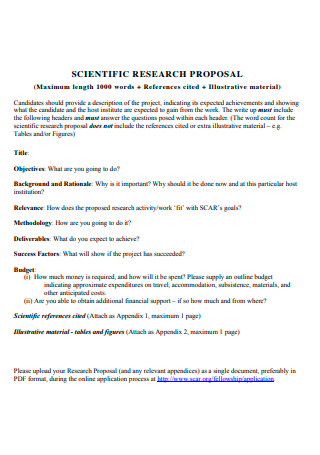
Printable Scientific Research Proposal
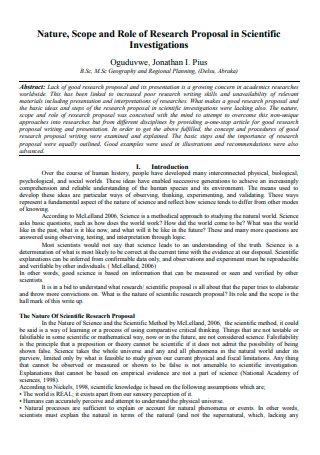
Scientific Investigation Research Proposal
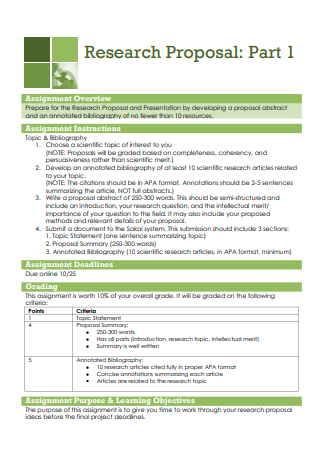
Standard Scientific Research Proposal

Scientific Research Elective Proposal

Scientific Research Proposal in DOC
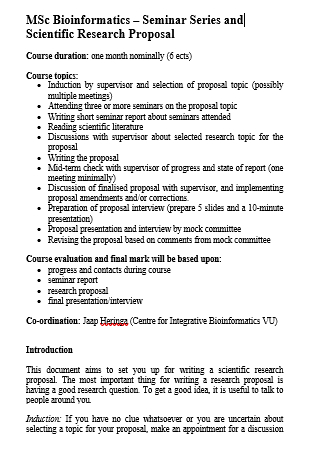
Seminar Series and Scientific Research Proposal
Introduction, literature review.
- Independent Variables – These are manipulated variables that makes difference from other variables.
- Dependent Variables – The results of these variables are the changes in the independent variables.
- Confounding Variables – These variables are to be studied carefully. It has a mixed influence on the independent variables.
- Background Variables – The variables that can get their relevance through investigations.
Research Hypothesis
Methodology.
- What are the criteria that you are going to use in your choices in the research?
- How can you define exclusion?
- What are the procedures that you are going to use to give reliability to the research and to minimize errors?
- How are you going to do discontinuation?
- How can you control things in your study?
Justification
Time schedule, bibliography, step 1: define your aims, step 2: make a work plan, step 3: set a budget, step 4: proposal template and format, share this post on your network, file formats, word templates, google docs templates, excel templates, powerpoint templates, google sheets templates, google slides templates, pdf templates, publisher templates, psd templates, indesign templates, illustrator templates, pages templates, keynote templates, numbers templates, outlook templates, you may also like these articles, 25+ sample construction company proposal in ms word.

Navigating the intricate world of construction demands a seasoned company with a proven track record. Our comprehensive guide on the Construction Company Proposal is your blueprint to understanding the…
8+ SAMPLE Drama Proposal in PDF
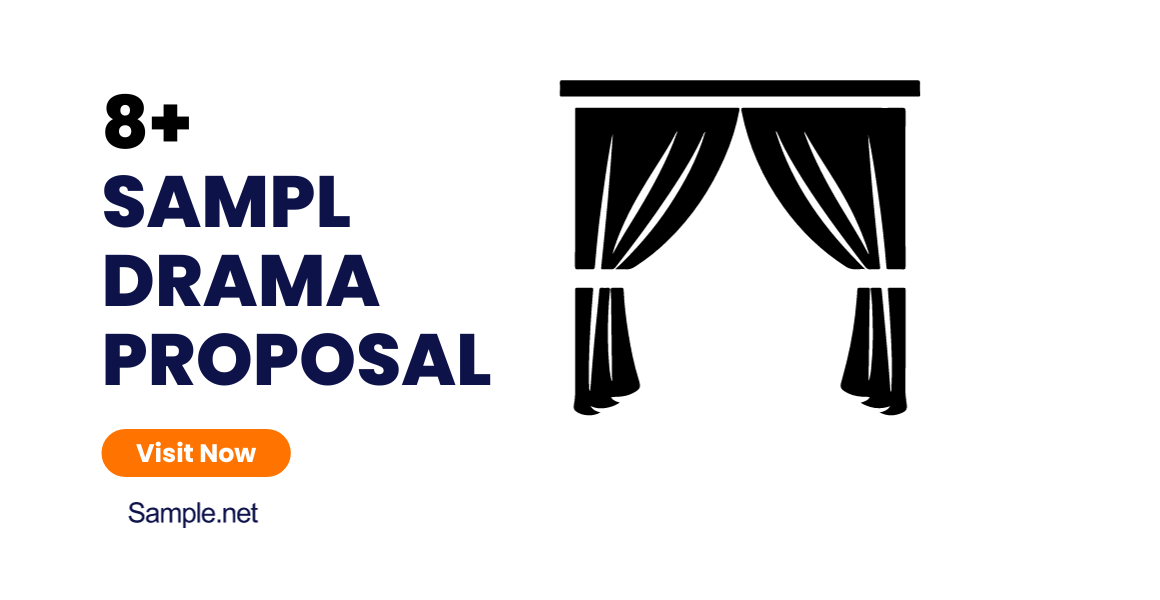
Julia Child said: “Drama is very important in life: You have to come on with a bang. You never want to go out with a whimper. Everything can have…
browse by categories
- Questionnaire
- Description
- Reconciliation
- Certificate
- Spreadsheet
Information
- privacy policy
- Terms & Conditions

- About NuWrite
- Writing Advice
- Engineering & Design
- First-Year Seminars
- Global Health
- Writing in the Humanities
- Lab reports: advice & samples
- Science posters: advice & samples
- Biology honors theses: advice & samples
Sample student biology research proposal (P. Pazos & P. Hirsch 2008)
- Grant / proposal writing
- What committees look for in evaluating a proposal
- Useful web links: citation and style advice from journals, etc.
- Style-advice-science-writing
- Science writing assignments & grading
- SRP-and-SRW
- Social Science Writing
- Writing for Graduate or Professional School
- Writing Advice for International Students
- Faculty-Only Resources
Sample student biology proposal with annotations about content and writing style

- Contact Northwestern University
- Campus Emergency Information
- University Policies
Northwestern University Library | 1970 Campus Drive, Evanston, IL 60208-2300 | Phone: 847.491.7658 | Fax: 847.491.8306 | Email: [email protected]

How do You Write a Project/Research Proposal for Life Science?
Writing a project/research/PhD proposal for life science, which includes biotechnology, microbiology, genetics and allied subjects, is certainly a different task. It often needs exposure to scientific writing and additional skills regarding the subject.
Students’ PhD endeavor starts by preparing the project or research proposal . It actually shows your interest, knowledge and planning for the project. An inadequately written proposal is immediately rejected by the supervisor.
Frankly speaking, students often prepare their project proposals to impress their guide, instead of showing their knowledge and interest. In addition, some students with knowledge fail too. In either scenario, the reason is clear.
Lack of academic writing experience.
Additionally, when we are talking about life science like pure research subjects, things become even more complicated. One has to demonstrate their writing, research and even experimental skills in the proposal.
Thus, it becomes important for students to understand how to write such a piece of academic write-up before doing anything else. I got my doctorate in one of the life science subjects, then moved to the academic writing field to solve our life science students’ problem of academic writing.
If you are searching this phrase, “ How do you write a project/research proposal for life science?” on the Internet and land on this page, you are on the right article and I am perhaps the right person.
So how can we do that? Let’s find out.
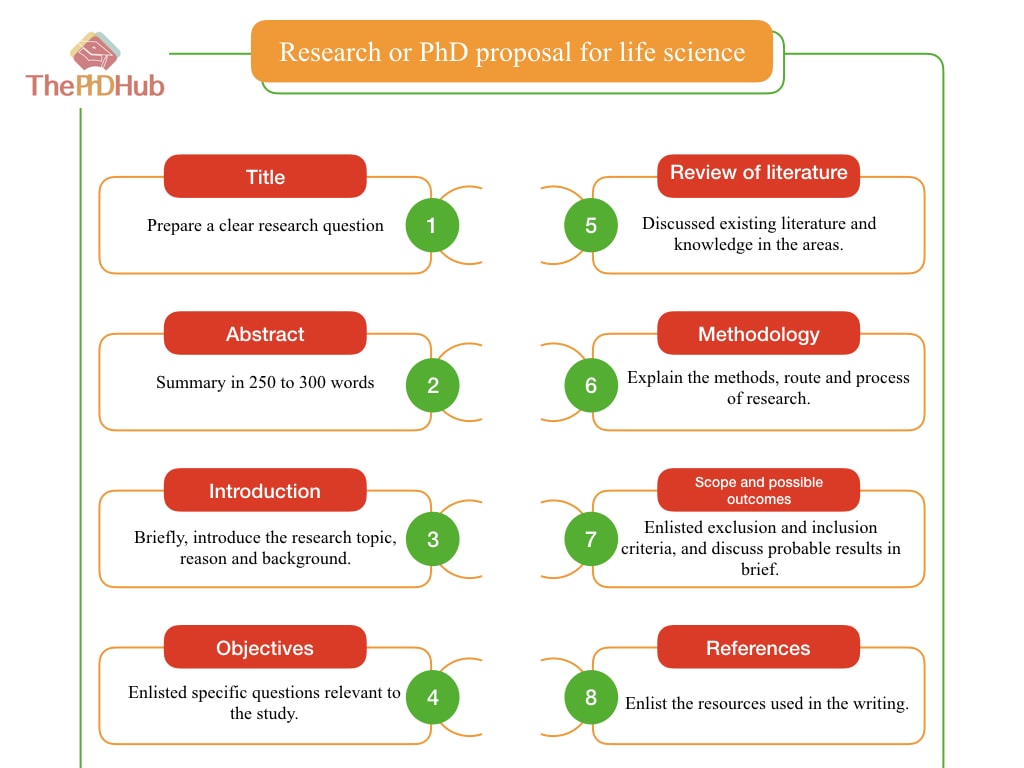
How do you write a project/research proposal for life science?
Every research proposal has some common elements, without which it looks incomplete. Oftentimes, a supervisor checks them first. For instance, it should have a background/ introduction, review of literature, methodology, scope and bibliography sections.
When you blankly initiate your life science project proposal writing, it looks easy, but when it gets rejected or you read things on the internet relevant, it becomes difficult. However, by avoiding common mistakes and following a usual guide, the student can write their own.
At this point, you might be willing to do a PhD, first understand that a life science subject research or project proposal is a different venture than a grant proposal and cover letter. So make it clear that you are writing a research proposal that is the same as a PhD or project proposal.
A life science research proposal is certainly a distinct proposal.
- It should have a comprehensive review of the literature section which discusses all of the major points relevant to the research question.
- The research title should be clear, and concise and must show a clear goal, objective, methods and techniques. I have discussed how to prepare a PhD title in our previous article. You can read it there.
- It should elaboratively explain the materials and methodology section. Wet lab experimentation has been significantly involved in life science research/PhD, so beyond doubts, this section must show how the experimental work would go.
- Also, it must demonstrate sampling, analytical and interpretation methods that help to obtain tentative results thereby achieving objectives.
- It should show the scopes of the study and possible outcomes in terms of societal or real-world importance.
- Lastly, Use correct citation and referencing “in-style.”
Moreover, Also keep in mind what should not be included here. Because after all, everything is covered within 10 to 12 pages (including references).
Things to avoid:
- Give a brief background of the topic. Avoid explaining everything here.
- Review associated research, in brief. Keep in mind that it would justify the research question. Do not discuss separate reviews here.
- Avoid including every possible utility that you are going to use, for example, glassware, plasticware, and instruments, etc. Discuss the SOP, route or road map using which the objectives will be achieved.
- Discuss the method which you have selected, not the technique, in the long run you might have to change the technique. For example,
- Avoid giving a clear statement regarding the results. Instead, enlist possible outcomes. For example,
- Do not claim anything in the research proposal. For example,
Research proposal template for life science:
Research work plan: .
I have specifically highlighted the last segment because it is very important and must be included in the research plan, however, students usually avoid it or do not even have an idea about it. Surprisingly, I was not aware of it until I showed it in one of my student’s proposals.
It is amazing, indeed, even I was impressed! It definitely proclaims your interest and preparation for doing research or PhD. It needs a comprehensive explanation to prepare that I think deserves a separate article. Here I am only giving you the template.
Costume PhD writing services:
If you are worried about your research proposal and still lack the concept of how to do it. Leave it to us. I and My team are experienced life science scientists who can do the job for you. Send us an email on [email protected] or [email protected] to get more information.
We can prepare a costume proposal as per your requirements. Remember, we believe in expertise and our’s is in life science. We only accept writing work related to our subject.
Wrapping up:
Life science subjects need attention on so many things. Their focus would be on lab work and hence they face problems in writing such assignments. Sometimes, only bad writing becomes a reason for rejection. This comprehensive guide perhaps benefits you. Still, if you are not sure, contact us, we will help you.
Also, take a tour of our blog, my team has written some amazing articles that certainly help you in your PhD endeavors. If you want to share your PhD experience, please mail us. We will publish your journal to motivate others.

Dr. Tushar Chauhan is a Scientist, Blogger and Scientific-writer. He has completed PhD in Genetics. Dr. Chauhan is a PhD coach and tutor.
Share this:

- Share on Facebook
- Share on Twitter
- Share on Pinterest
- Share on Linkedin
- Share via Email
About The Author

Dr Tushar Chauhan
Related posts.

How to Choose the best Thesis Writing Service in 2022?
1 thought on “how do you write a project/research proposal for life science”.
What’s Going down i’m new to this, I stumbled upon this I’ve found It positively useful and it has aided me out loads. I am hoping to give a contribution & help different users like its helped me. Great job.
Leave a Comment Cancel Reply
Your email address will not be published. Required fields are marked *
Save my name, email, and website in this browser for the next time I comment.
Notify me of follow-up comments by email.
Notify me of new posts by email.

IMAGES
VIDEO
COMMENTS
Here are real-life research proposal examples of funded research projects in the field of science and technology. Funder. Title. US Geological Survey (USGS) (Mendenhall Postdoctoral Research Fellowship) Using Integrated Population Modelling in Decision-support Tools to Connect Science and Decision Makers.
Research Proposal Example/Sample. Detailed Walkthrough + Free Proposal Template. If you're getting started crafting your research proposal and are looking for a few examples of research proposals, you've come to the right place. In this video, we walk you through two successful (approved) research proposals, one for a Master's-level ...
17 Research Proposal Examples. By Chris Drew (PhD) / January 12, 2024. A research proposal systematically and transparently outlines a proposed research project. The purpose of a research proposal is to demonstrate a project's viability and the researcher's preparedness to conduct an academic study. It serves as a roadmap for the researcher.
Abstract: This is a brief (300-500 words) summary that includes the research question, your rationale for the study, and any applicable hypothesis. You should also include a brief description of your methodology, including procedures, samples, instruments, etc. Introduction: The opening paragraph of your research proposal is, perhaps, the most ...
Research proposal examples. Writing a research proposal can be quite challenging, but a good starting point could be to look at some examples. We've included a few for you below. Example research proposal #1: "A Conceptual Framework for Scheduling Constraint Management" Example research proposal #2: "Medical Students as Mediators of ...
The design elements and procedures for conducting research are governed by standards of the predominant discipline in which the problem resides, therefore, the guidelines for research proposals are more exacting and less formal than a general project proposal. Research proposals contain extensive literature reviews.
Research Proposal Examples/Samples. In the video below, we provide a detailed walkthrough of two successful research proposals ... This varies tremendously, depending on the university, the field of study (e.g., social sciences vs natural sciences), and the level of the degree (e.g. undergraduate, Masters or PhD) - so it's always best to ...
What's Included: Research Proposal Template. Our free dissertation/thesis proposal template covers the core essential ingredients for a strong research proposal. It includes clear explanations of what you need to address in each section, as well as straightforward examples and links to further resources. The research proposal template covers ...
A proposal needs to show how your work fits into what is already known about the topic and what new paradigm will it add to the literature, while specifying the question that the research will answer, establishing its significance, and the implications of the answer. [ 2] The proposal must be capable of convincing the evaluation committee about ...
Research proposals. Your research proposal is a key part of your application. It tells us about the question you want to answer through your research. It is a chance for you to show your knowledge of the subject area and tell us about the methods you want to use. We use your research proposal to match you with a supervisor or team of supervisors.
institution you are applying to. However, if you are not given any guidelines on how to format your research proposal, you could adopt the suggested structure below. This is also relevant if you are applying for external funding or asking your employer to sponsor you to undertake a research degree. Suggested structure for a research proposal:
Here is an explanation of each step: 1. Title and Abstract. Choose a concise and descriptive title that reflects the essence of your research. Write an abstract summarizing your research question, objectives, methodology, and expected outcomes. It should provide a brief overview of your proposal. 2.
It puts the proposal in context. 3. The introduction typically begins with a statement of the research problem in precise and clear terms. 1. The importance of the statement of the research problem 5: The statement of the problem is the essential basis for the construction of a research proposal (research objectives, hypotheses, methodology ...
Research Proposal Format Example. Following is a general outline of the material that should be included in your project proposal. I. Title Page II. Introduction and Literature Review (Chapters 2 and 3) A. Identification of specific problem area (e.g., what is it, why it is important). B. Prevalence, scope of problem.
This is where you will want to work with your mentor to craft the experimental portion of your proposal. Propose two original specific aims to test your hypothesis. Don't propose more than two aims-you will NOT have enough time to do more. In the example presented, Specific Aim 1 might be "To determine the oncogenic potential of Brca1 null ...
Sample Research Proposals. You will find here two examples of proposals for postgraduate research from the Department of Social Policy and Criminology. They both give good indication of the sorts of things that need to be included. The first, on fathering after divorce or separation, represents first thoughts on the proposed topic, but sets out ...
A proposal for scientific research is an essential document that comprises research goals, objectives, and methods created by the researchers or scientists as they work on their curious mind with a deep knowledge of a specific or many areas of science and become intensely focused on the research problem, especially to attain research grants and ...
The goal of a research proposal is to present and justify the need to study a research problem and to present the practical ways in which the proposed study should be conducted. The design elements and procedures for conducting the research are governed by standards within the predominant discipline in which the problem resides, so guidelines ...
Step 3: Set a Budget. Because a scientific research proposal needs funding, you have to set a particular budget for your research. You need to include a budget that you will request in the proposal. Through the work plan, you will know the materials that you are going to use in the research.
Science posters: advice & samples; Biology honors theses: advice & samples; Science-proposals-grants. Sample student biology research proposal (P. Pazos & P. Hirsch 2008) Grant / proposal writing; What committees look for in evaluating a proposal; Useful web links: citation and style advice from journals, etc. Style-advice-science-writing
Postulate a clear, concise and descriptive title. 1. Abstract. A 250 to 300 words small summary of the proposal. Half page. Section 1: Introduction. Introduce your research topic, give a thorough background and reason to choose the present topic. 1.5. Review of literature.
Step 4: Define the Project Deliverables. Defining your project deliverables is a crucial step during the project proposal process. Stakeholders want to know just what it is you're going to be delivering to them at the end of the project. This could be a product, a program, an upgrade in technology or something similar.
2) The Literature Review. • Focus on scholarly (peer-reviewed) sources: instructors will usually provide guidelines to let you know the minimum number of books and peer-reviewed articles. • The lit review is both the hardest and easiest part of a research proposal. o It's easiest in the sense that it's pretty easy to do a search on ...